Herpetology Lab
1/74
There's no tags or description
Looks like no tags are added yet.
Name | Mastery | Learn | Test | Matching | Spaced |
|---|
No study sessions yet.
75 Terms
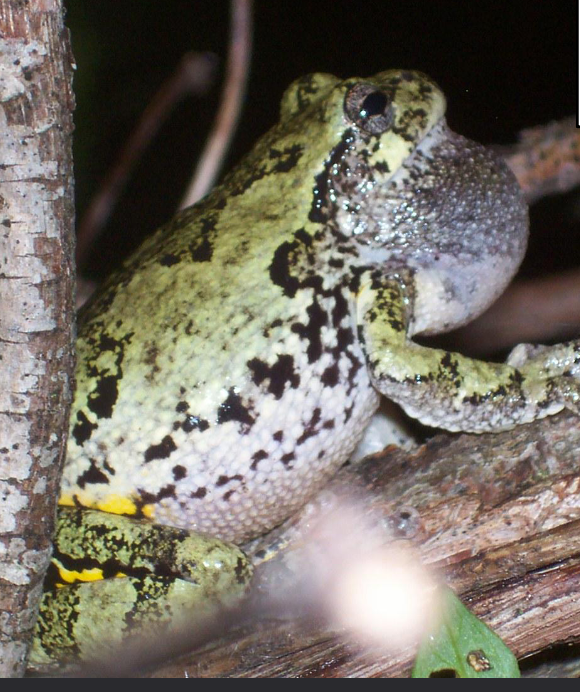
What is this
Dryophytes versicolor
Gray tree frog
Not assessed
Family Hylidae
Tree Frog
For my reference: found on Manitoulin Island
Colour may vary depending on environment conditions but usually born, grey, and green
Toe pads are large
Dark strip runs from behind the eye to the front leg
Found in trees and shrubs
Inside legs are orange
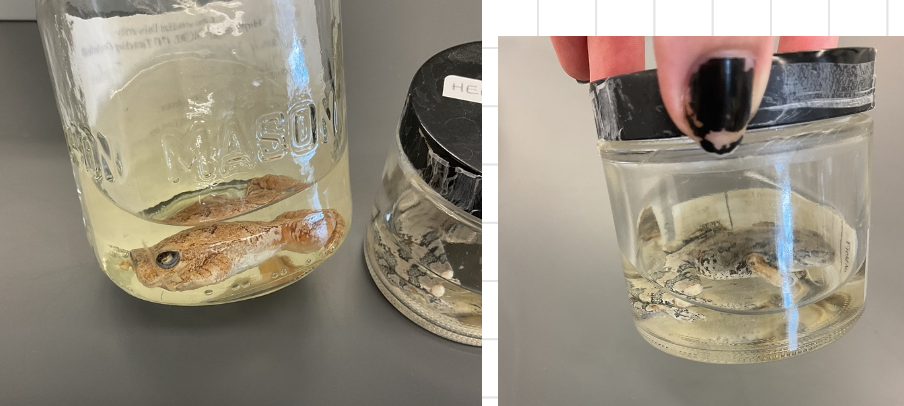
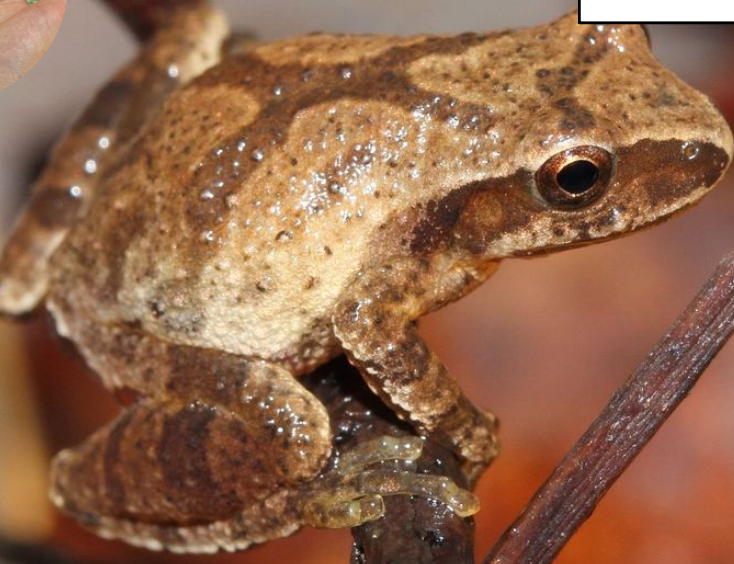
What is this
Pseudacris crucifer
Spring peeper
Not assessed
Family Hylidae
Very small
Tree Frog
Loud call despite its size
X on back --> crucifer
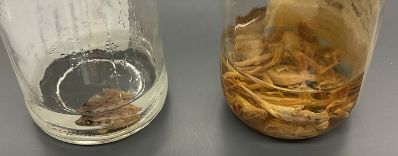
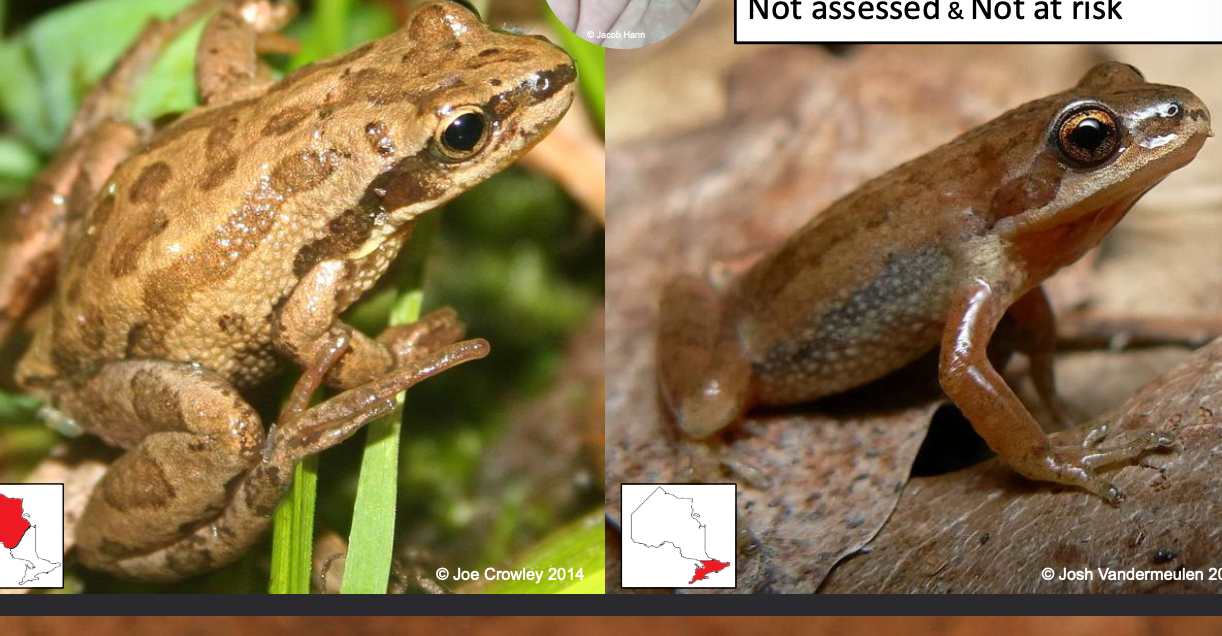
What is this
One on right:
Pseudacris triseriata
Western chorus frog
Not at risk
Lines on back
Brown, gold, grey, orange, green
Upper lip has a white stripe
One on left:
Pseudacris maculata
Boreal Chorus frog
Not assessed
Tree Frog
Looks similar to Pseudacris crucifer but does not have X on back
Has spots
Boreal has fewer frogs in high latitude in the north
Hind limbs are short
brown or grey gold, orange, green with dark stripes or splots
There is a black line that goes around face through the eyes like a triangle.
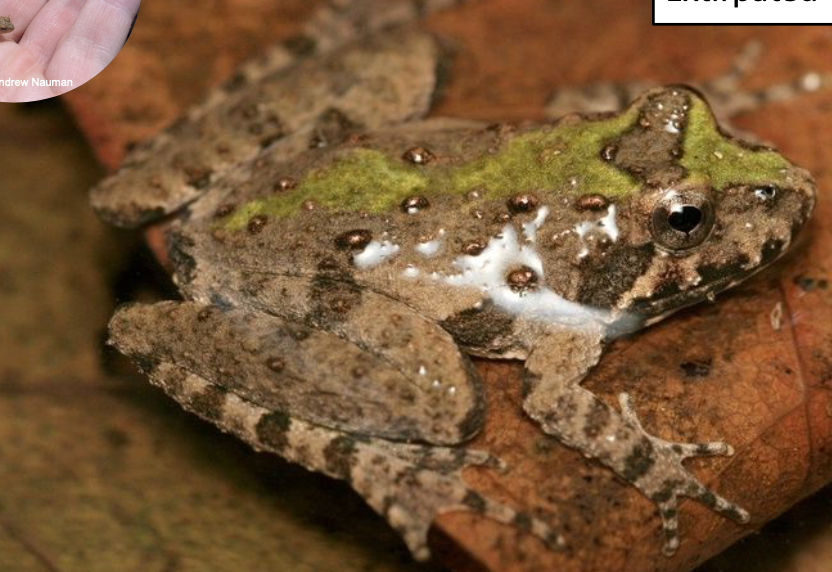
What is this
Acris blanchardi
Blanchard's cricket frog
Extripated from Ontario
Family Hylidae
Tree Frog
Mostly aquatic
Spots on back
Has a green line splot on bWhat ack
Warty projections on back
Has a triangle blotch on head
Bellies are white
Found Pelee Island in Lake Erie
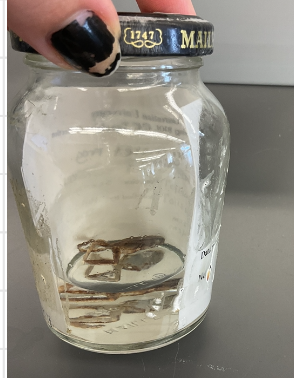
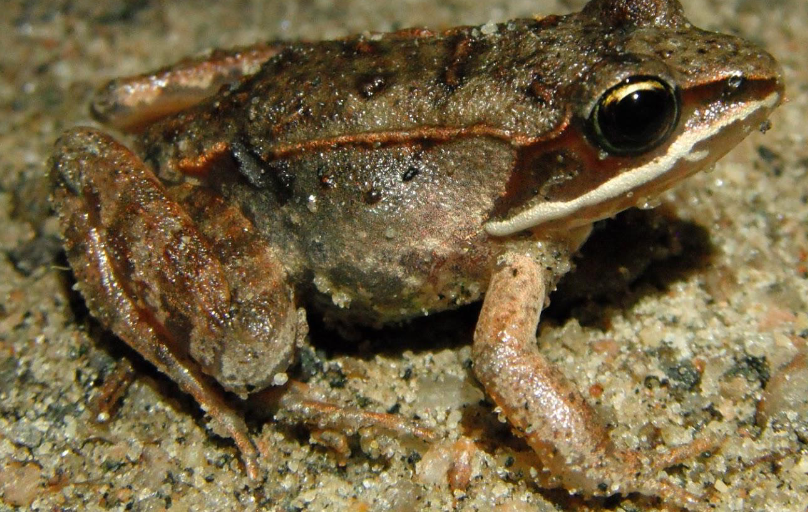
What is this
Lithobates sylvaticus
Wood frog
Not assessed
Family Ranidae
Has a dark mask on face
White line on upper lip
Found in grass and lawns
They do not freeze and tolerates the cold
Dorsolateral ridge present
Dark brown, light brown, and bronze and orange in colour
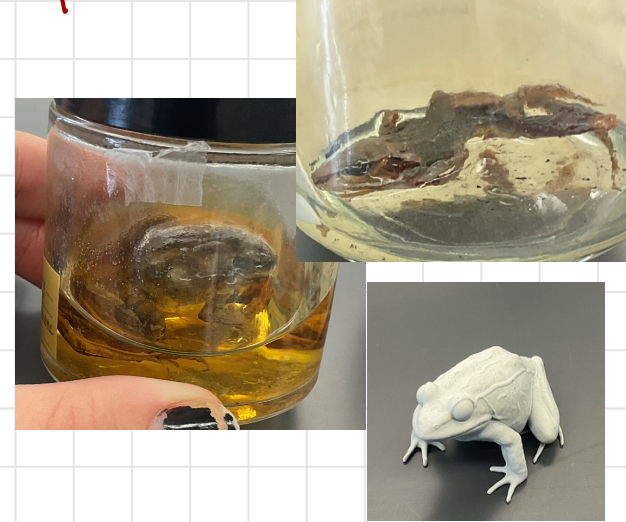
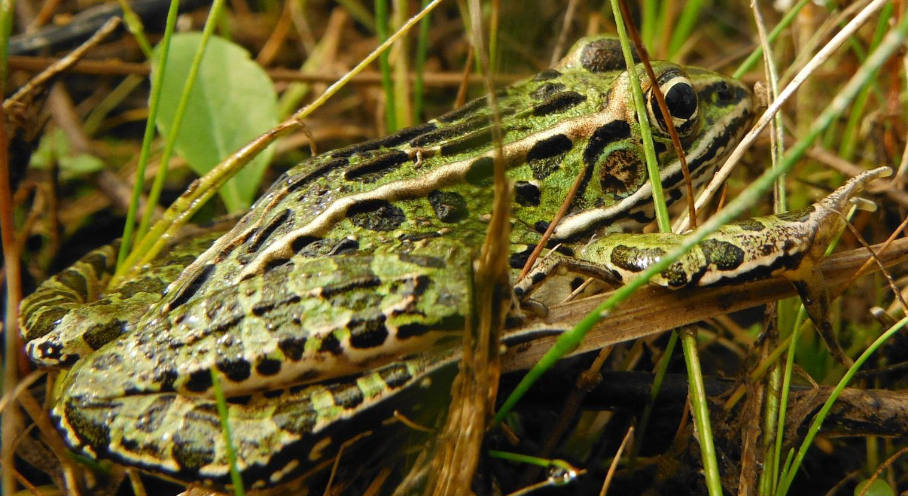
What is this
Lithobates pipiens
Northern leopard frog
Not at risk
Family Ranidae
Very common
Very green or brown
Dorsolateral folds on back
Spots
Random pattern
White belly and under legs
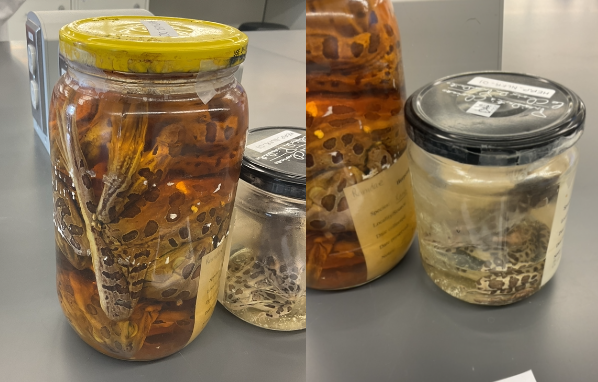
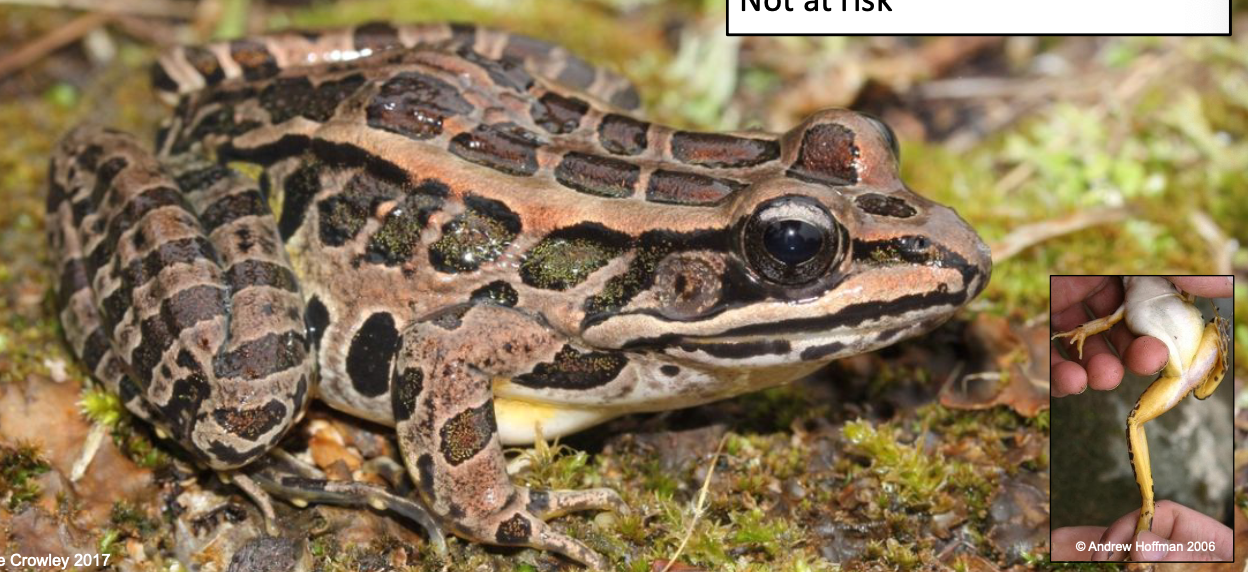
What is this
Lithobates palustris
Pickerel Frog
Not at risk
Family Ranidae
Spots are rectangular or square
2 distinct rows on back
Dorsolateral folds on back
Yellow under legs
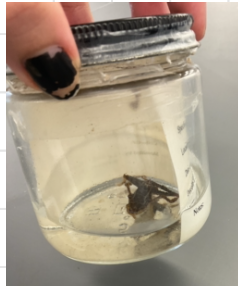
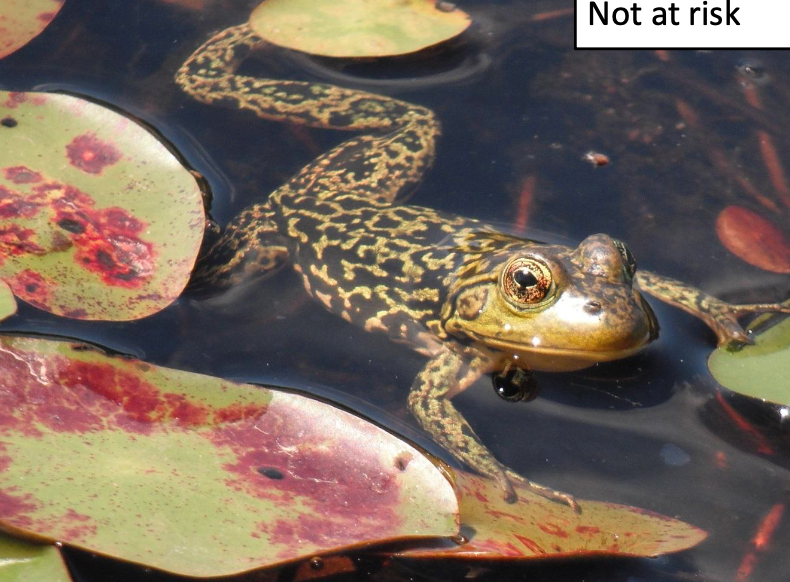
What is this
Lithoabtes septentrionalis
Mink frog
Not at risk
Family Ranidae
White and yellow bellies
Green and brown colours
Dark blotches over rear legs
Dorsal ridges extends to over half the length of body
Have a musk odour when disturbed
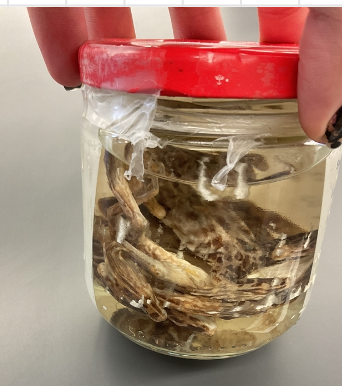
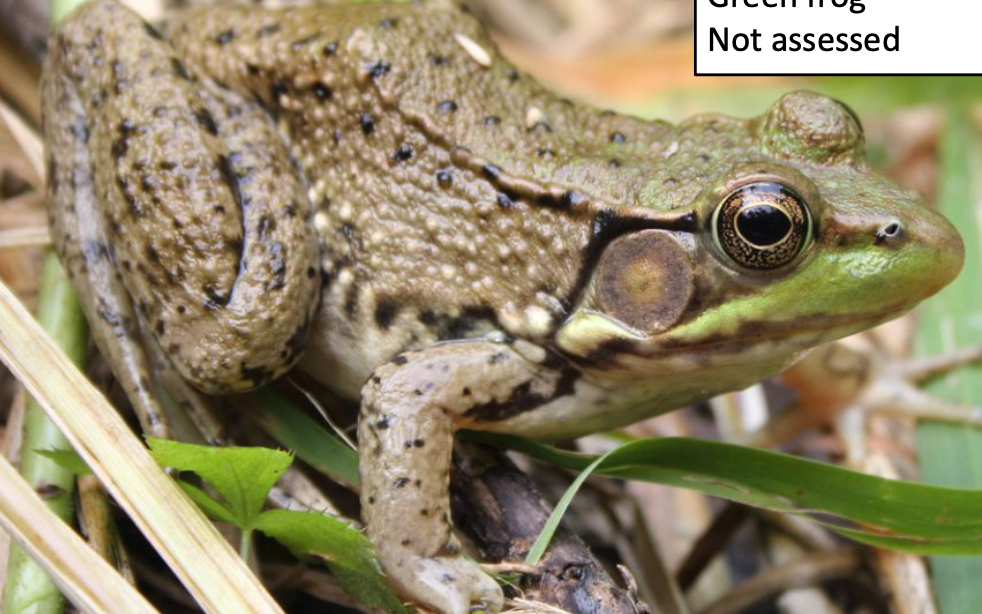
What is this
Lithobates clamitans
Green frog
Not assessed
Family Ranidae
Tapanum is larger than eye
green, olive, brown colour
Dorsolateral ridge extends over half the length of the back
Upper lip is yellow to light green
Belly is white
Males have yellow throats
Top of thighs have crossbands
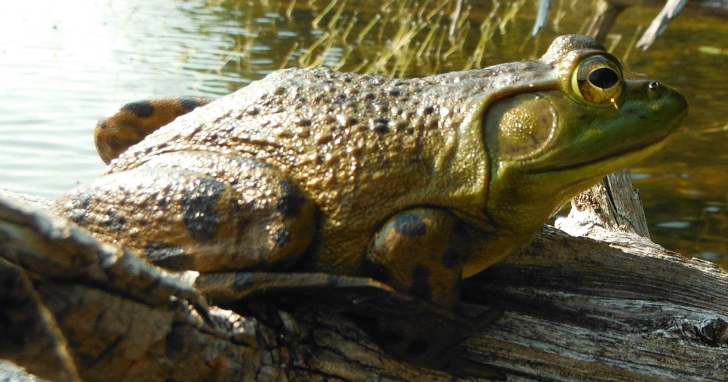
What is this
Lithobates catesbeianus
Bullfrog
Not assessed
Family Ranidae
Dorsolateral folds are around the tamanum instead of down the body
Summer breeding
Yellow throats
Biggest frog specimen in North America
Eats everything: frogs, snakes, birds, etc
Green, love, or yellow, brown
Belley may be pure white or mottles grey.
Crossbands but may be blotched on some individuals.
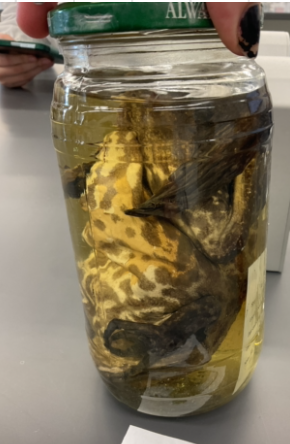
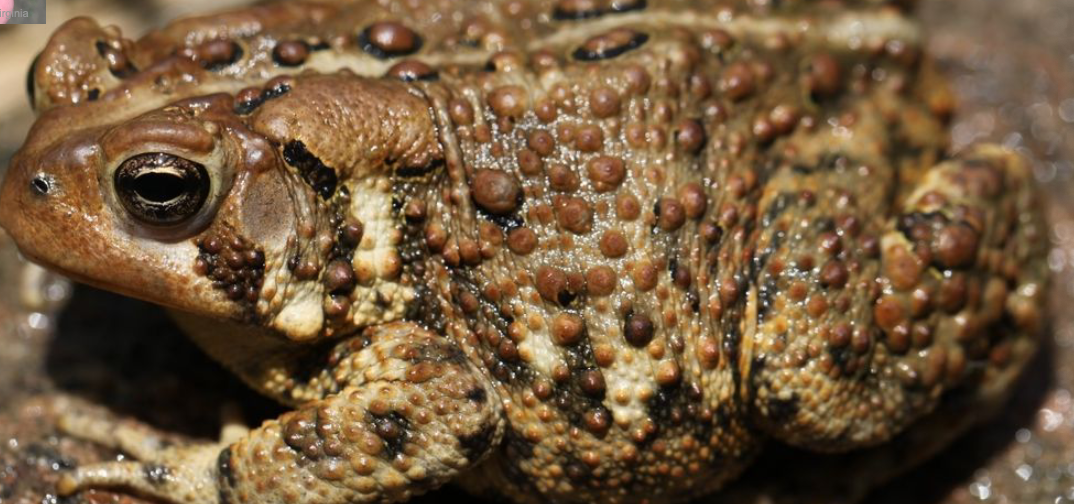
What is this
Anaxyrus americanus
American toad
Not assessed
Family Bofonidae
Warts are always in 1-2 within each black spot on back
Brown, beige, yellow, red, green with brown or black flecks and spots
Paratoid gland is present behind eye
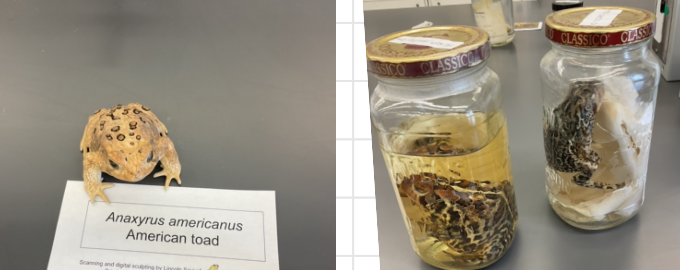
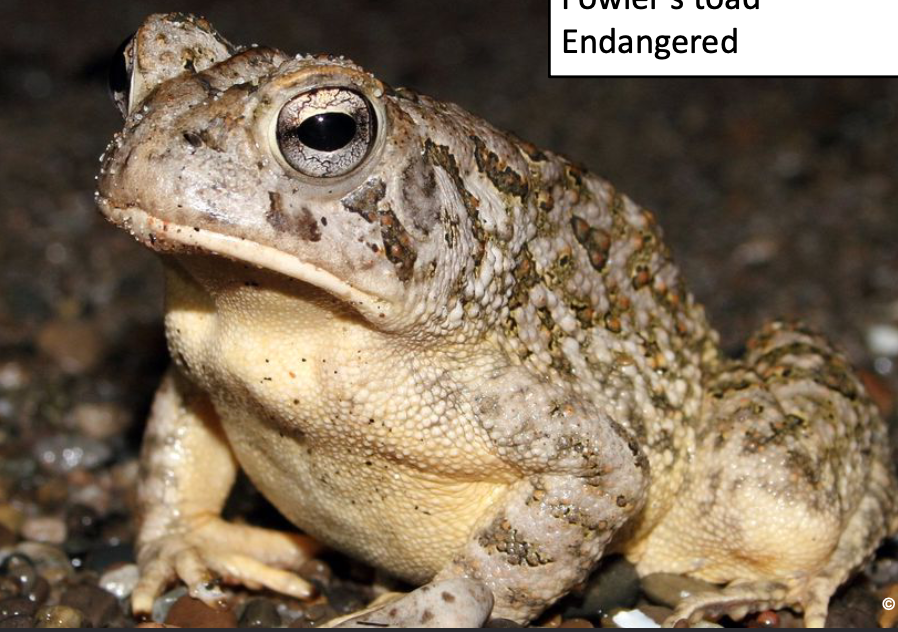
What is this
Anaxyrus fowleri
Fowler's toad
Endagered
Family Bofonidae
Grey, tan, brown, grey colour
Brown or black flecks and spots
Within each large black spot on the back there are 3 warts present
Paratoid gland is present behind eye
Belly is white or cream with no or little grey marking
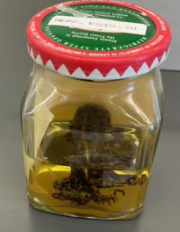

What is this
Ambystoma maculatum
Spotted salamander
Not assessed
Family Ambystomatidae
Short bodied
Dark grey, brown, or black colours
2 rows of bright yellow spots running down the back and tail
The belly and lower sides are grey
Young one doe not have large yellow spots yet.
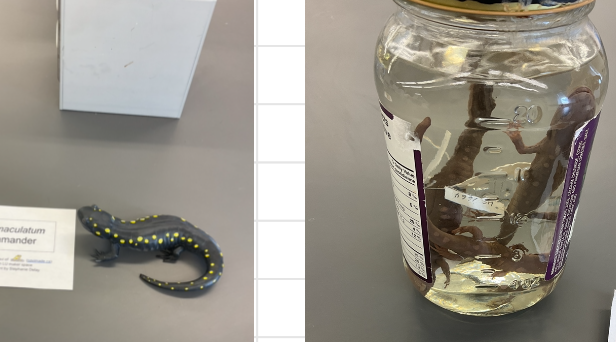
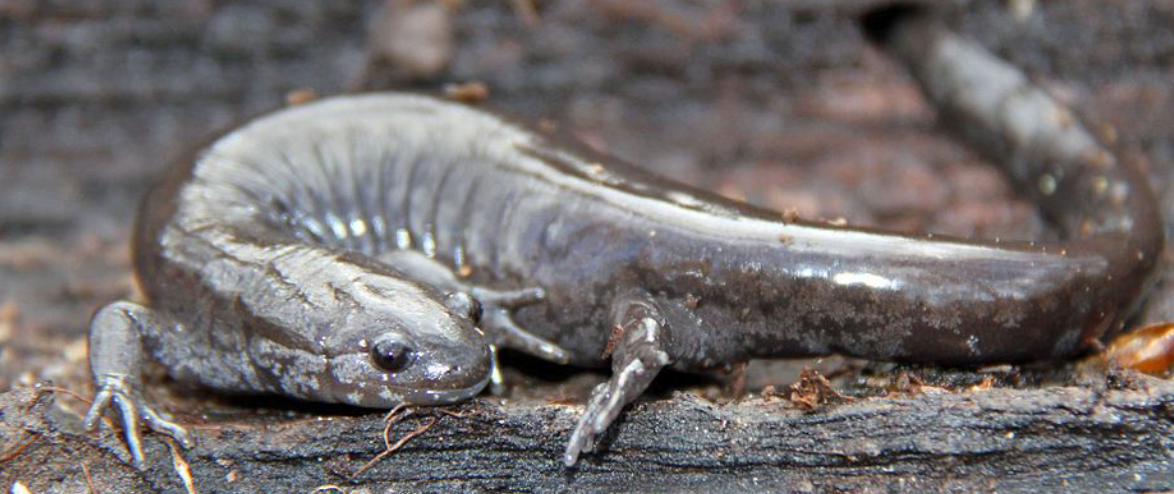
What is this
Ambystoma texanum
Small-mouthed salamander
Endangered
Family Ambystomatidae
Sploty spots and blotchy
Small headed
Short snout
Grey, grey-blue or white flecking
Belly is dark grey with some blue motting
Asexually
Females have multiple sets of chromosomes
14-16 costal groovesAmbAmbystoma ystoma
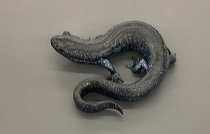
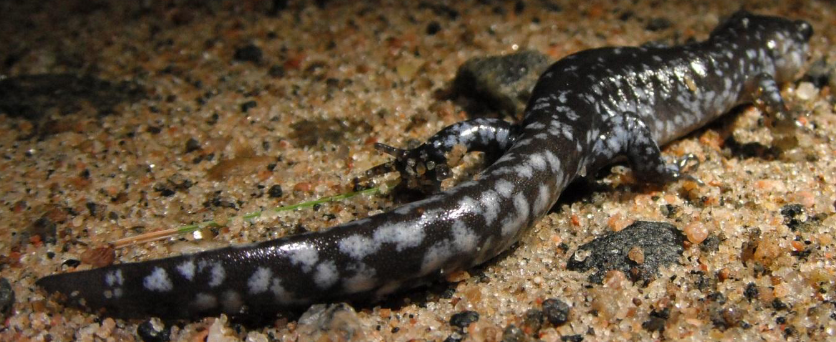
What is this
Ambystoma laterale
Blue spotted salamander
Not assessed
Family Ambystomatidae
Large tale which is 40% of body length
Lots of blue spots
13-14 coastal grooves
They are subtarainial when they are not breeding
Dark grey to black colour
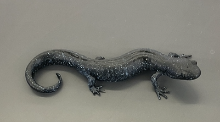
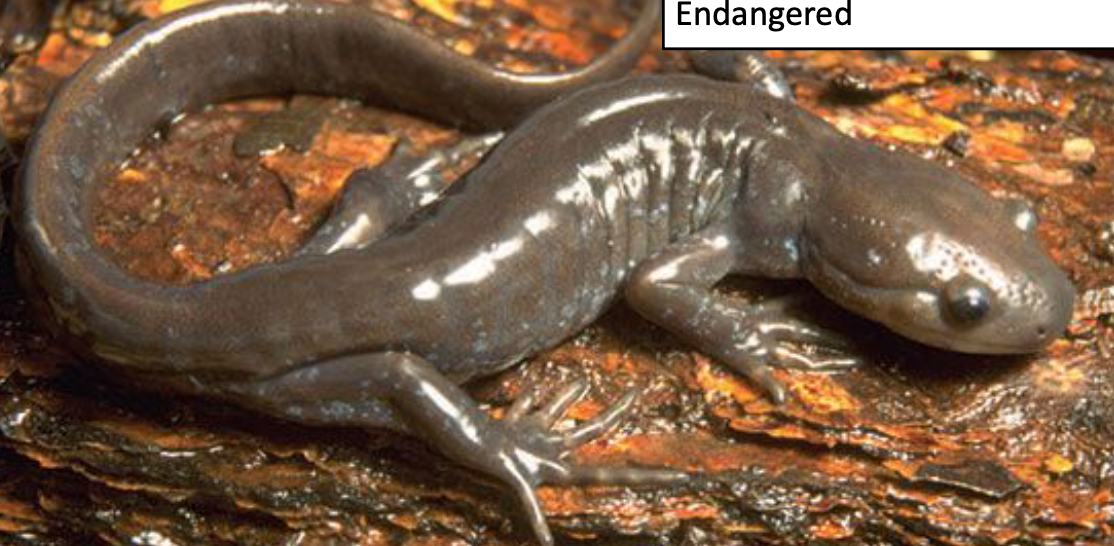
What is this
Ambystoma jeffersonianum
Jefferson's salamander
Endangered
Family Ambystomatidae
Less blue spots
Long snout and toes
12-14 costal grooves
Grey to brown in colour with blue spots on body
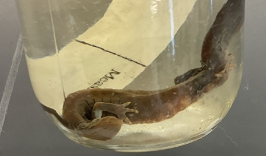
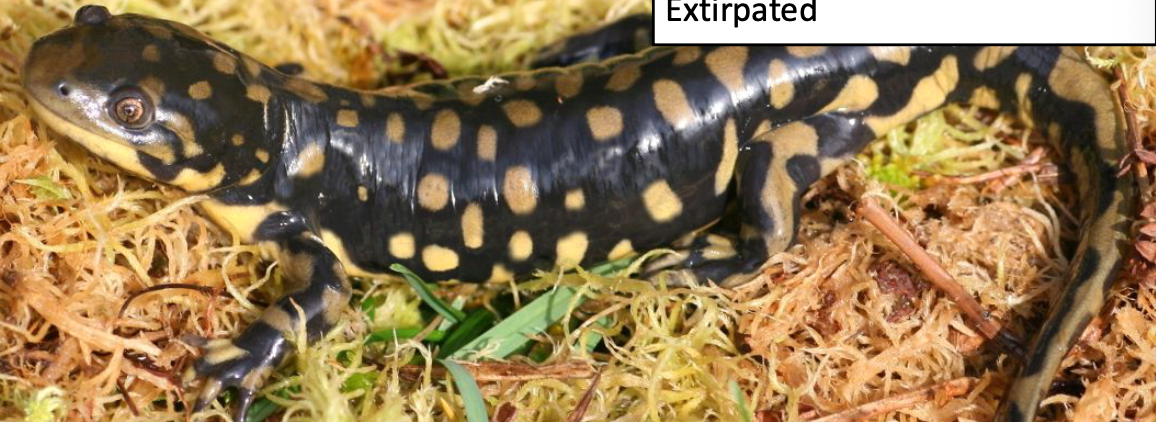
What is this
Ambystoma tigrinum
Eastern tiger salamander
Extripated
Family Ambystomatidae
Black with yellow to olive blotches spots and strips
Head is broad
Rounded snout and small eyes
Tail is laterally compressed
Some species in the US has external gills and lives aquatic lives
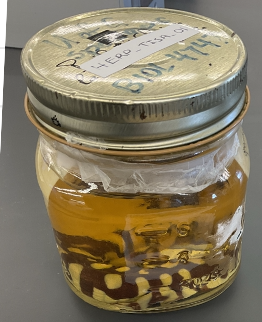
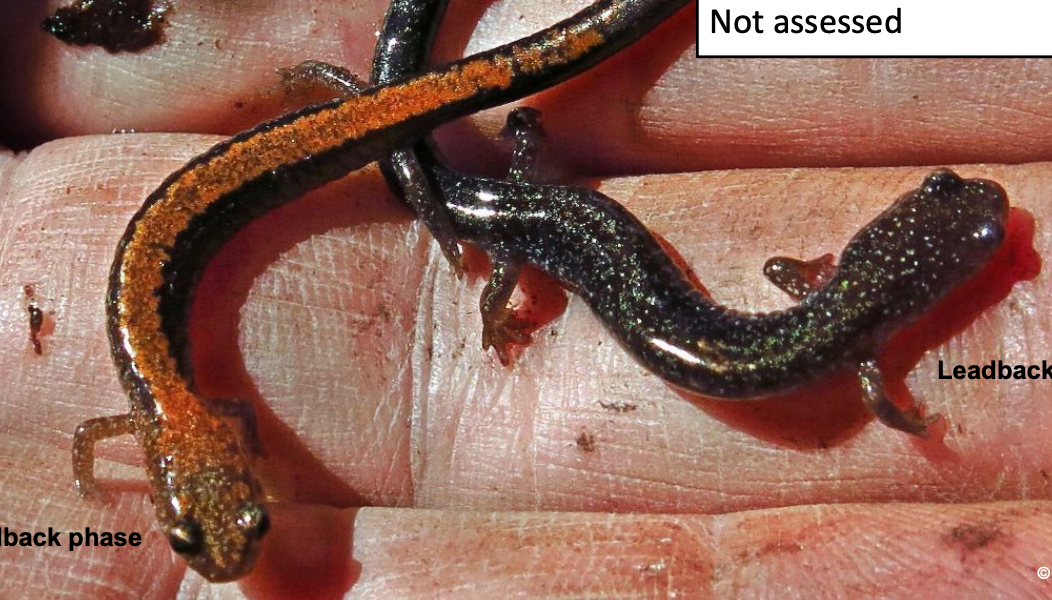
What is this
Plethodon cinerus
Eastern Red-backed Salamander
Not assessed
Family Plethodontidae
Red or black dorsal line
Belly is grey
7-9 costal grooves
Lay eggs on land until they hatch into mini adults
They are erythristic (black and sides bright red) colour variations are occasionally found
Body is slender with a long tail and small legs
Have 2 phases: redback and leadback
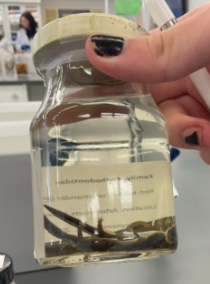
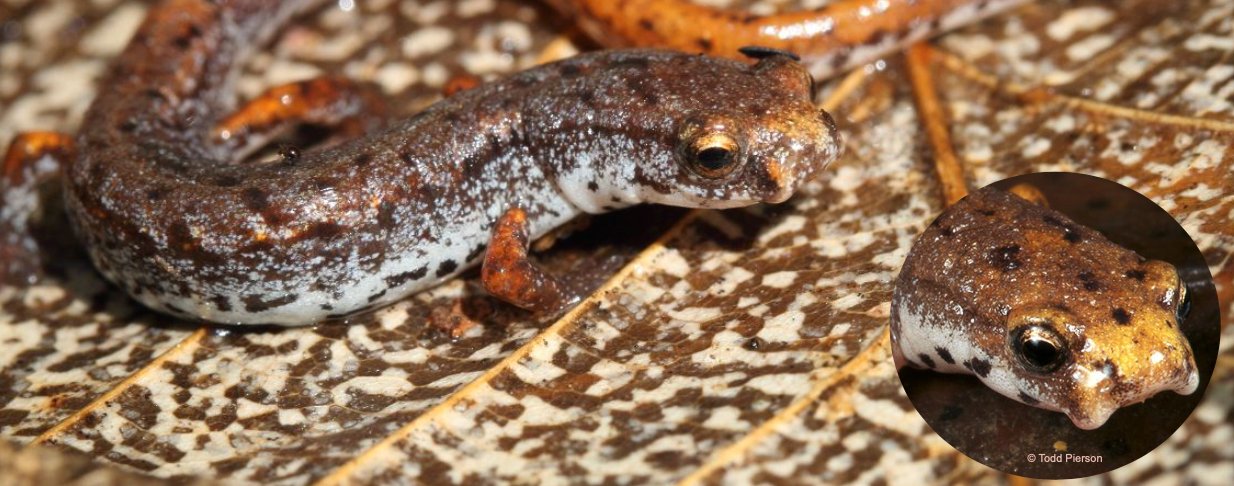
What is this
Hemidactylium scutamum
Four-toed salamander
Not at risk
Family Plethodontidae
4 toes on rear feet
White belly with black spots
Nose looks weird
They drop their tails when scared or feel threatened
Red-brown to gold colouring
Small black flecks across the back, tail, head and sides
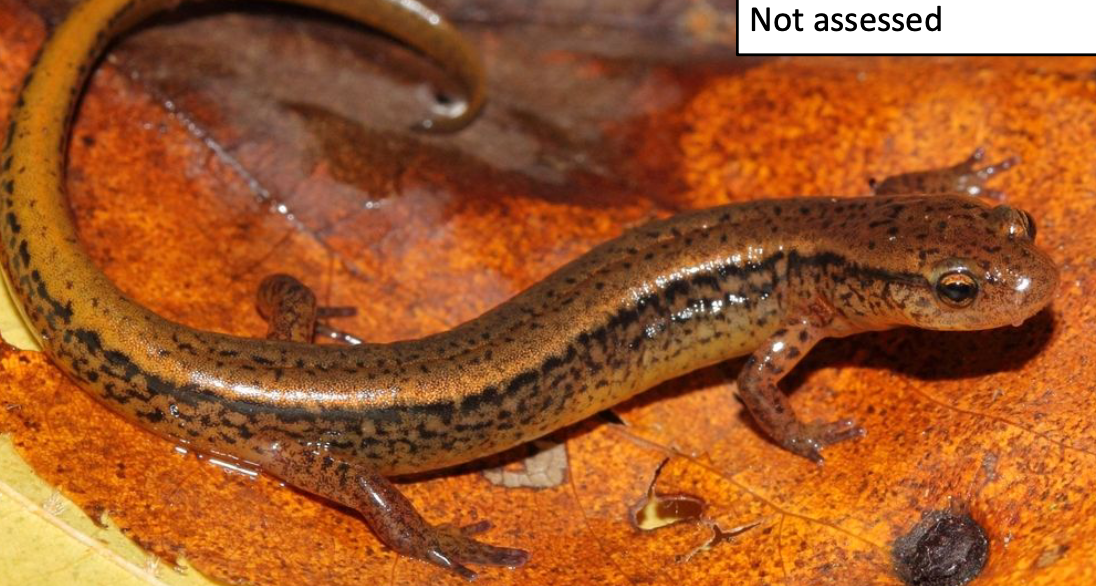
What is this
Eurycea bislineata
Northern Two-lined salamander
Not assessed
Family Plethodontidae
15-16 costal grooves
Yellow, green, or tan strip running down the body
Strip may contain black flecks
Strip is outlined by a thin black line on each side
Belly is cream to yellow
Found by fast flowing streams where their body is adapted to the flowing stream
Slender body with short legs
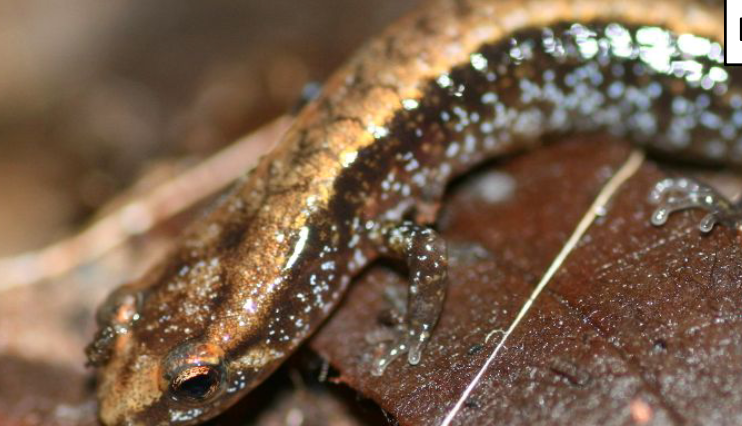
What is this
Desmognathus ochrophaeus
Allegheny mountain dusky
Endagered
Family Plethodontidae
Back legs are bigger than the front legs
V-shape markings on back
Red, dark brown side body
Dark or light flecks may be on upper body
Head is broad
Belly is grey to brown with light and dark flecks
Tail is round
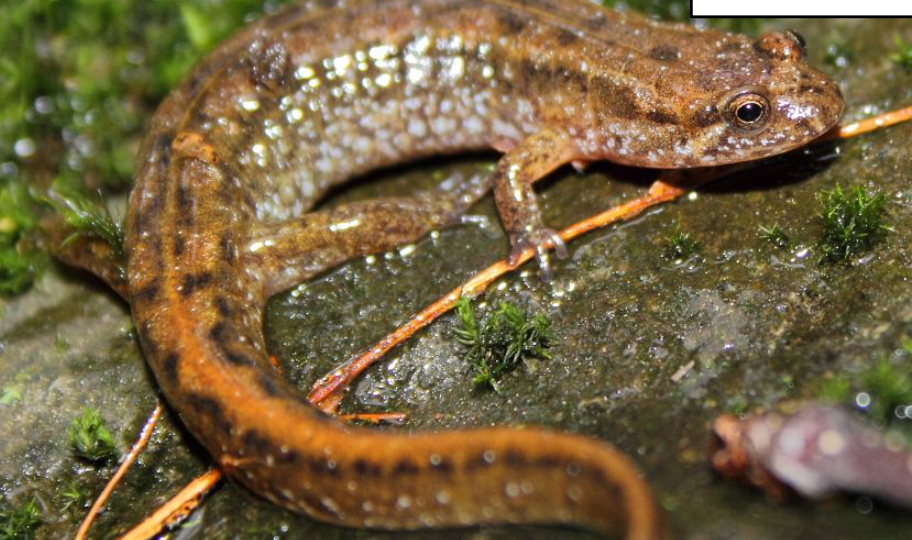
What is this
Desmognathus fuscus
Northern dusky
Endangered
Family Plethodontidae
Does not have V-shape on back
Tail is lateral compressed
Found in Niagra
Grey and brown colouring
Grey, yellow, brown, red, or green strip running down the length of body
Dark or light flecks are visible across body
White to grey belly with grey or white flecks on it
Older individuals may appear darker
Head is broad
Back legs are larger than front ones
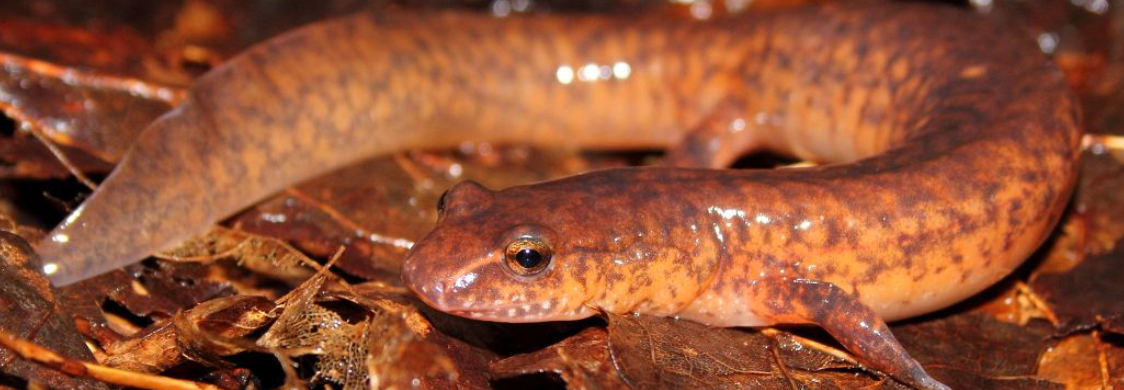
What is this
Gyrinophilus porphyriticus
Northern Spring salamander
Data deficient
Family Plethodontidae
Yellow, brown, pink, red, orange colour with grey mottling
Snout its square
Laterally compressed tail with ridge
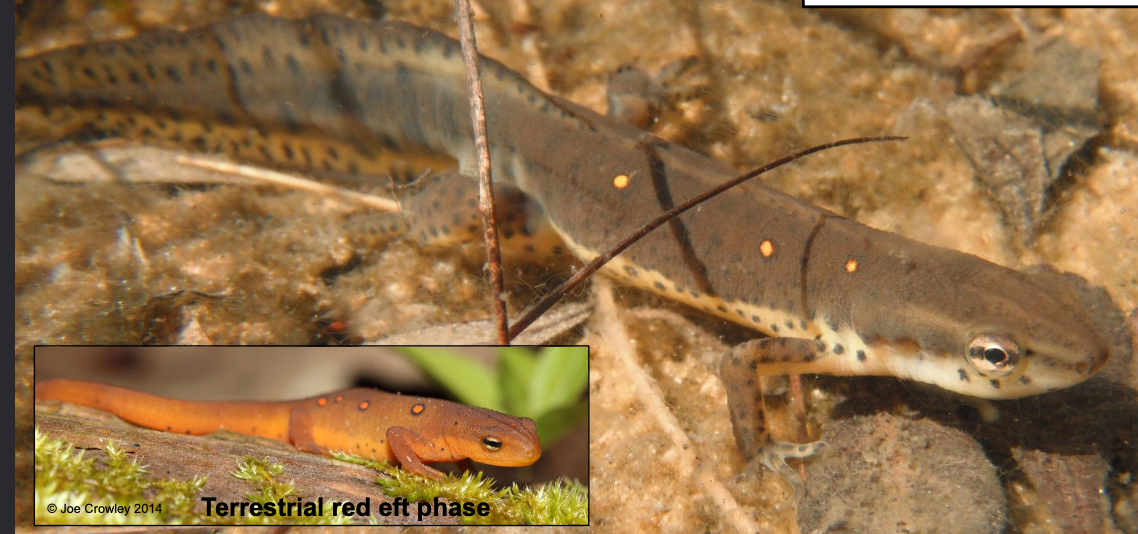
What is this
Notophthalmus viridescens
Eastern red-spotted newt
Not assessed
Family Salamandridae
Red spots with black boarder
Yellow and black spots on belly
Eggs will hatch into a juvenile phase or into a larva phase
Tail is laterally compressed
In breeding, the males back legs are enlarged
During the red eft stage individuals are bright red, orange, olive or brown
When they are older they are brown
NO COSTAL GROOVES

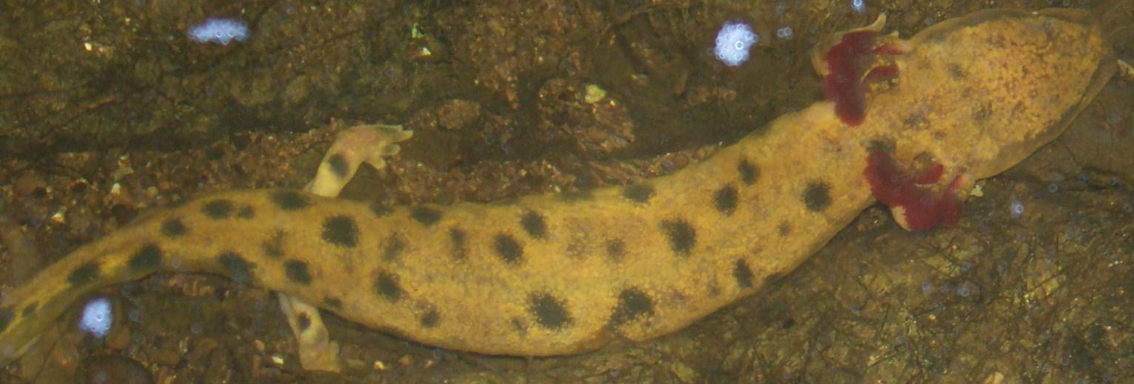
What is this
Necturus maculosus
Mudpuddy
Special concern
Family Proteidae
Large head and flat
External gills
Spotted
Found in rivers, lakes, and streams
Active in winter
Belly is grey, cream, or yellow with dark spots
Legs are small
Tail is laterally compressed
Fully aquatic
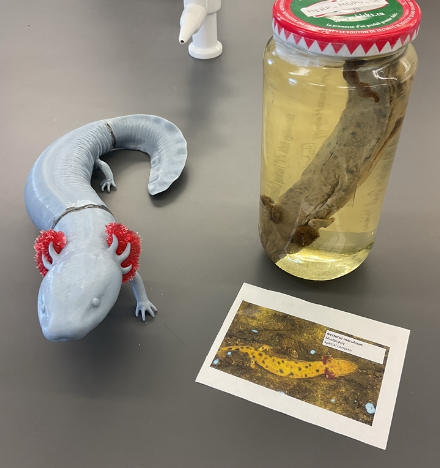
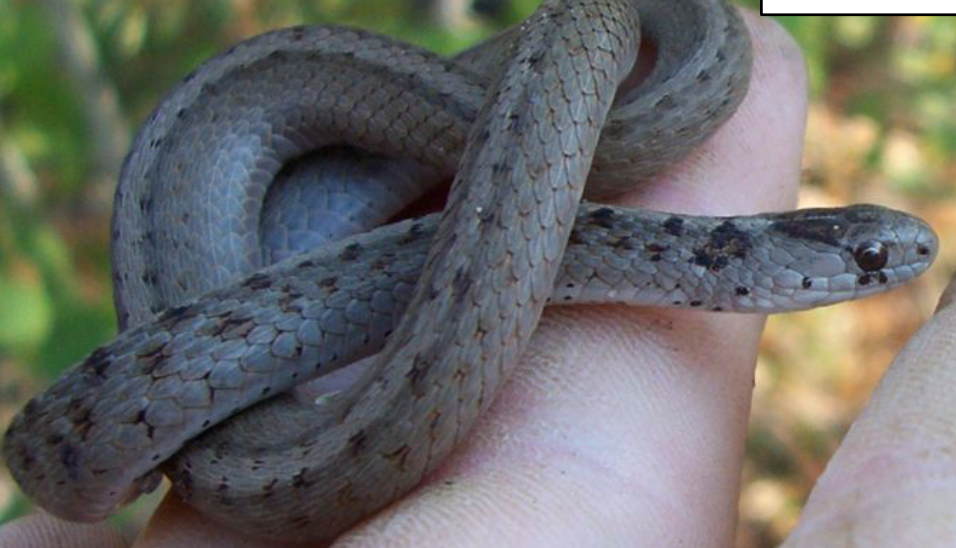
What is this
Storeria dekayi
DeKay's Brownsnake
Not assessed
Family Colubridae
Small
2 rows of black spots on body that is outlining/bordering a lighter beige dorsal stripe
Blue belly
They are hard to find
Body is grey-beige in colour
Dark bar begin either side of the head
Small dark blotch beneath the eye can be ssen
Found in urban environments beneath wood, rocks or leaves
if threatened they may flatten its body to appear larger and release an odorous fluid from its cloaca
Scales are keeled

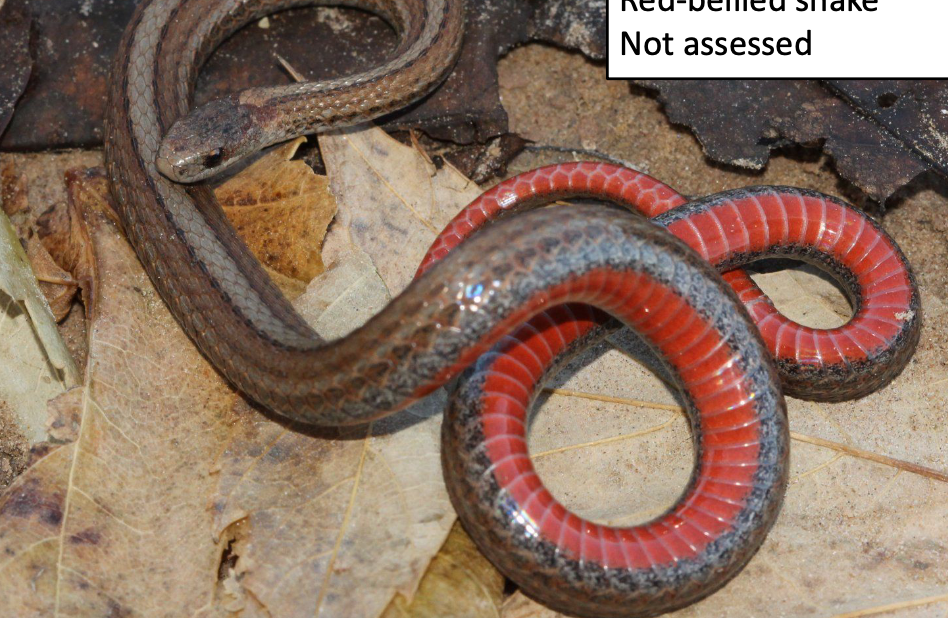
What is this
Storeria occipitomaculata
Red-bellied snake
Not assessed
Family Colubridae
Small
Bright red bellies
Dorsal background can be grey, brown, or red
4 dark stripes are present dorsally and laterally
Small head
Under chin is white
If threatened may flatten its body to appear larger, expose its red belly or release an odours fluid from its cloaca
Found in forests, fields, rocky areas
Eats inverterates
Ontarios smallest snake
Scales are keeled
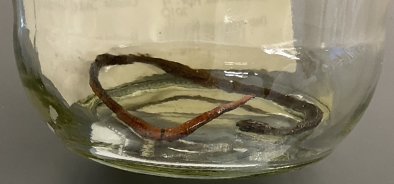

What is this
Diadophis punctatus
Northern Ring-necked snake
Not assessed
Family Colubridae
Bright yellow belly
White ring around head/under head
Lays eggs in the summer
Found in moist environments
Active at night
If threatened they may release an odorous flood from its cloaca and writhe if handled
Scales are smooth
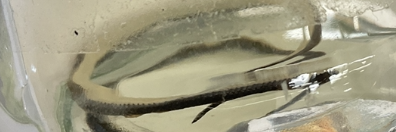
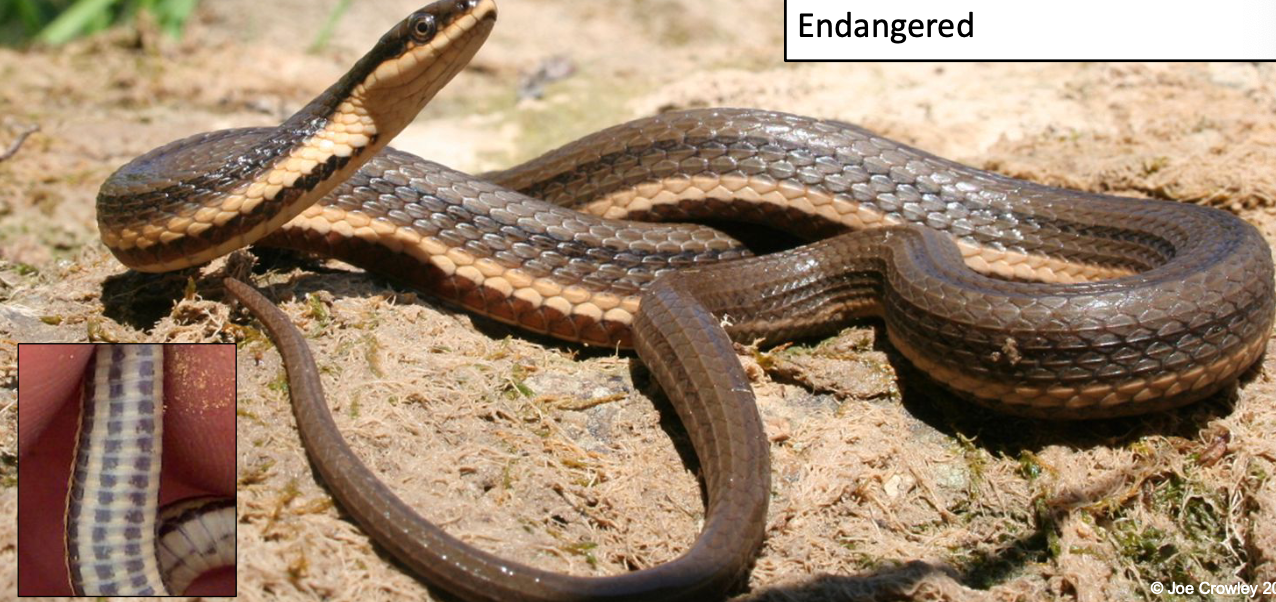
What is this
Regina septemvittata
Queensnake
Endangered
Family Colubridae
Brown, olive, or grey colouring
Cream coloured lateral stripes that run the length of body
Belly is cream to yellow and cam become grey to tan with age
If threatened they may release a foul-smelling fluid from its cloaca and if captured it will keep withering
Feeds mainly on moulted crayfish
Snales are keeled
Big eye
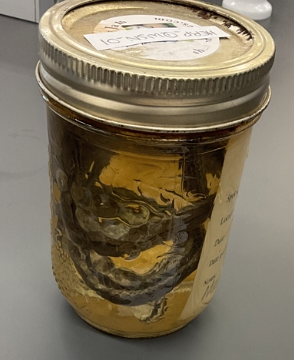

What is this
Thamnophis sirtalis
Eastern gartersnake
Not assessed
Family Colubridae
Cream to yellow strip under belly
Mating call in the spring
3 light cream to yellow strips on body
Background of body is grey, olive, black or brown
Single strip is located mid-dorsally with a srtip on each side
Some may lack these strips and can have a checkerboard pattern
if threatened it may flatten its body to appear larger and release an odorous fluid from its cloaca
Scales are keeled
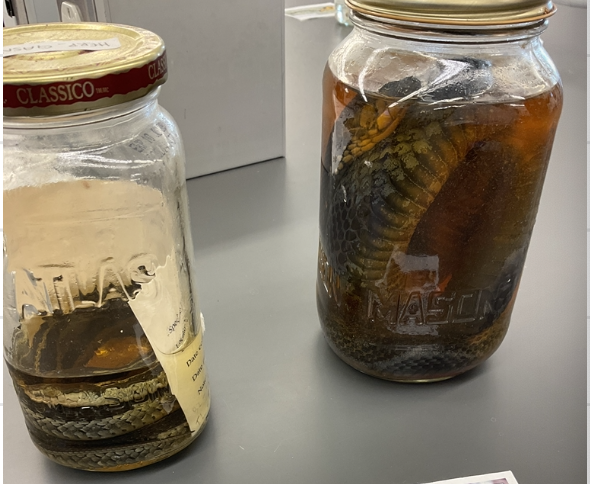
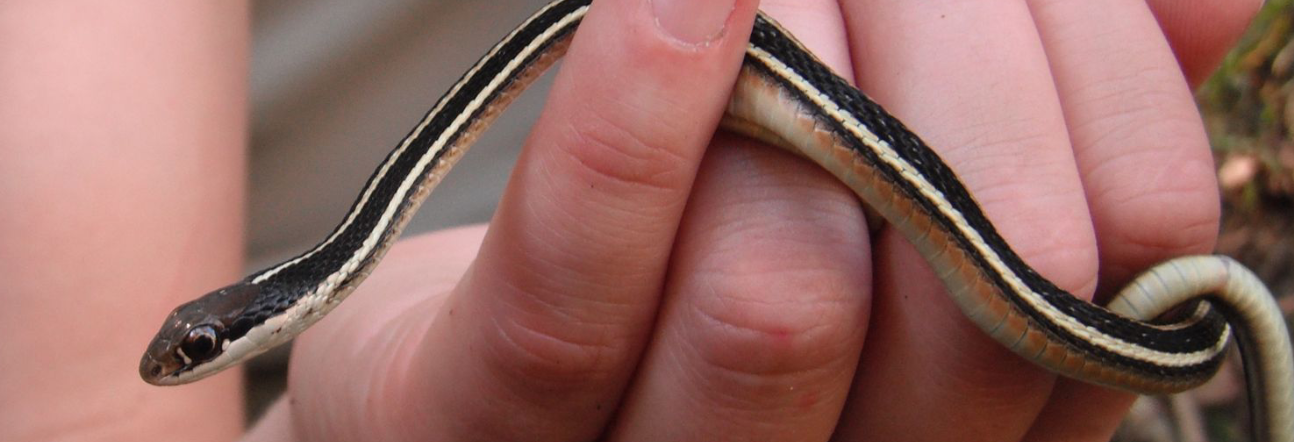
What is this
Thamnophis sauritus
Eastern Ribbonsnake
Special Concern
Family Colubridae
Small
Yellow with black strips down body
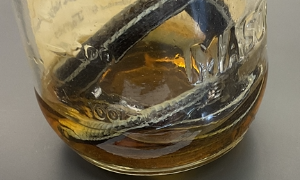
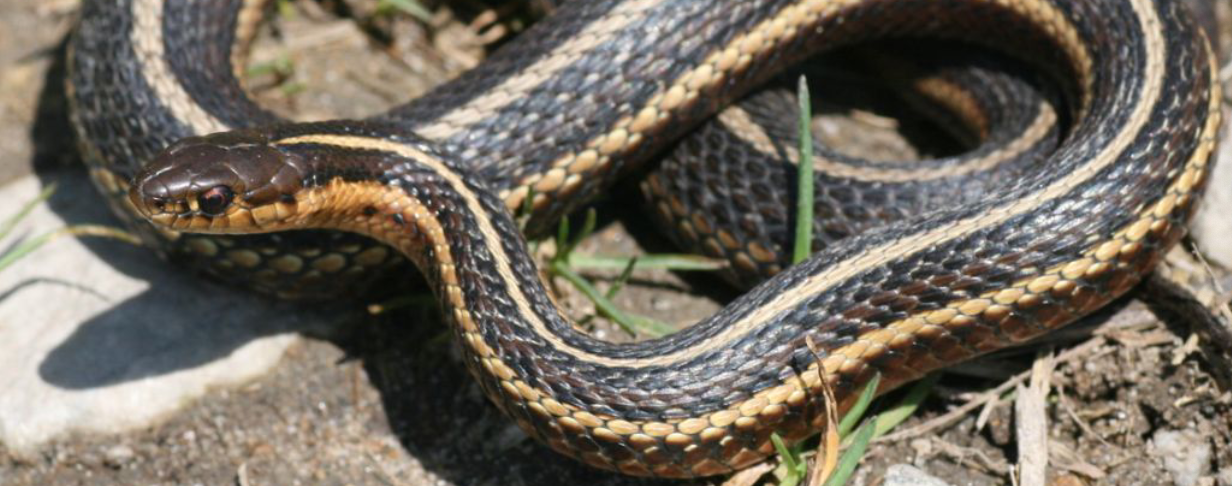
What is this
Thamnophis butleri
Butler's Gartersnake
Endagered
Family Colubridae
Feeds on earth worms
3 light cream to yellow strips on body
Background of the body is bloc or brown
Belly is tan to yellow often bordered with brown
Head is small and blunt
May have a light spot in front of the eye
When threatened it will flatten its body to appear larger and release an odorous fluid from its cloaca
Scales are keeled
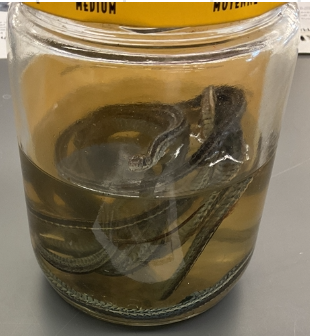
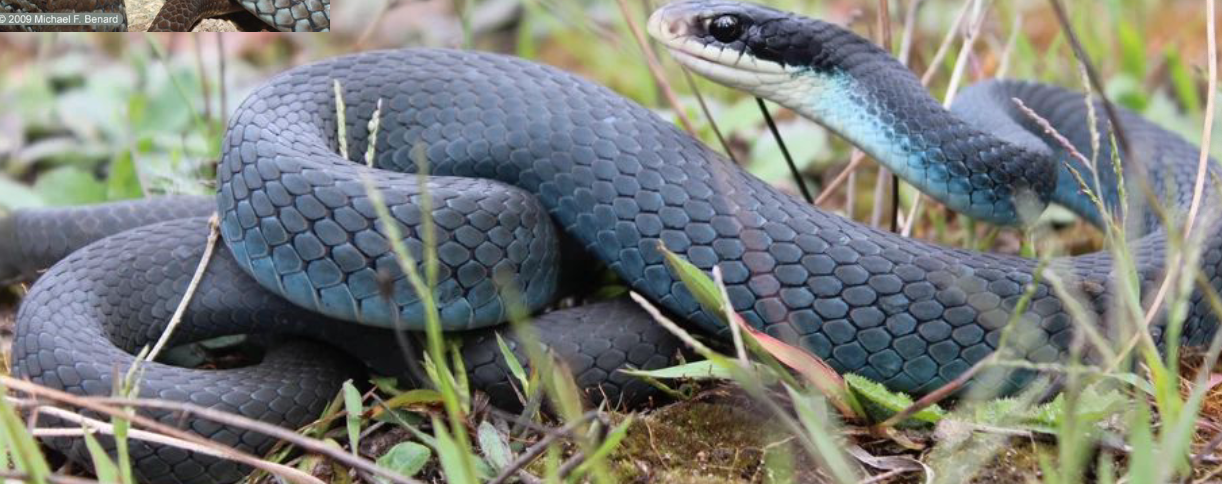
What is this
Coluber contrictor foxii
Blue Racer Snake
Endangered
Family Colubridae
Blueish colour with grey or brown
Belly is cream, grey, or blue-grey
Racoon style eyes
They do not constrict their prey despite its name but it does swallow its prey whole
Found on Pelee Island
If threatened they will vibrate its tail, release a foul-smelling fluid from its cloaca, assume a defensive strike position and actively defend itself if grasped
Speed/Fast
Scales are smooth
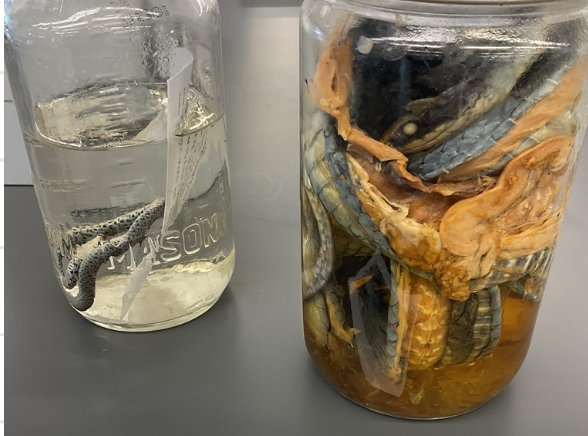
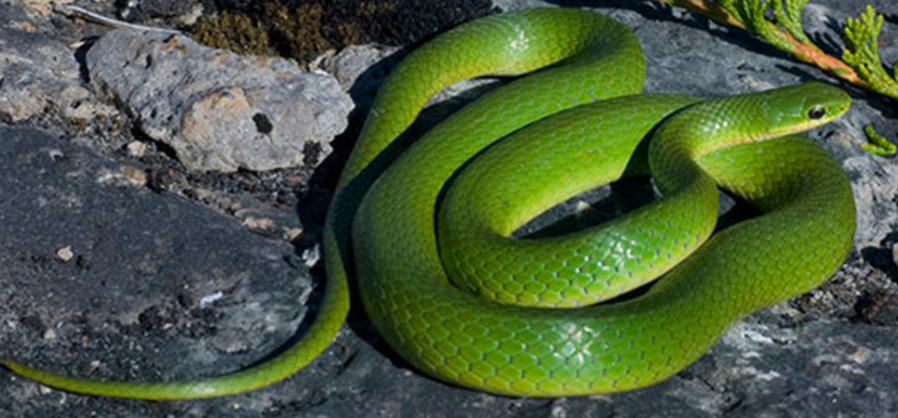
What is this
Opheodrys vernalis
Smooth Green Snake
Not assessed
Family Colubridae
Smooth scales
They turn blue when the die
They retain their eggs for a long time so the babies grow bigger faster
Its green with green-yellow lips, throat, and chin
Belly is white to cream
When they die they turn blue
They are very passive species but if threatened they may release a foul-smelling fluid from its cloaca
Found basking on shrubs, grasses, and ferns

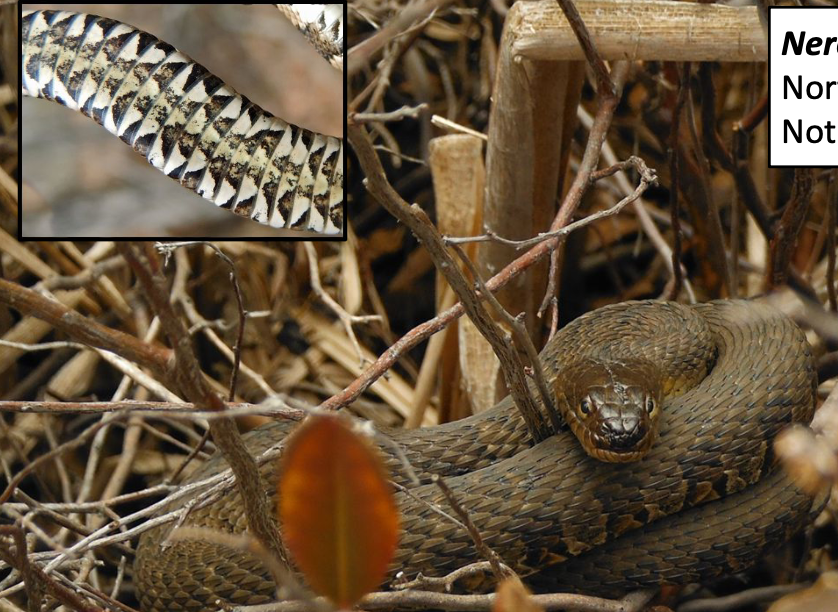
What is this
Nerodia spiedon spiedon
Northern Watersnake
Not at risk
Family Colubridae
Very keeled scales
Belly is cream to light orange with half-mooned shapes
Very aggressive
Gives birth to live children (viviparous)
Background colour is brown to grey with numerous brown, black, or rust-coloured blotches on body
The anterior of body is saddle-shape
Young are boldly patterned while old adults may appear mostly solid dark brown or black from a distance
Often mistaken for water moccasin
It is harmless to humans but will actively defend itself if handled or barrages, it will flatten its body to appear bigger and release an odours fluid from its cloaca

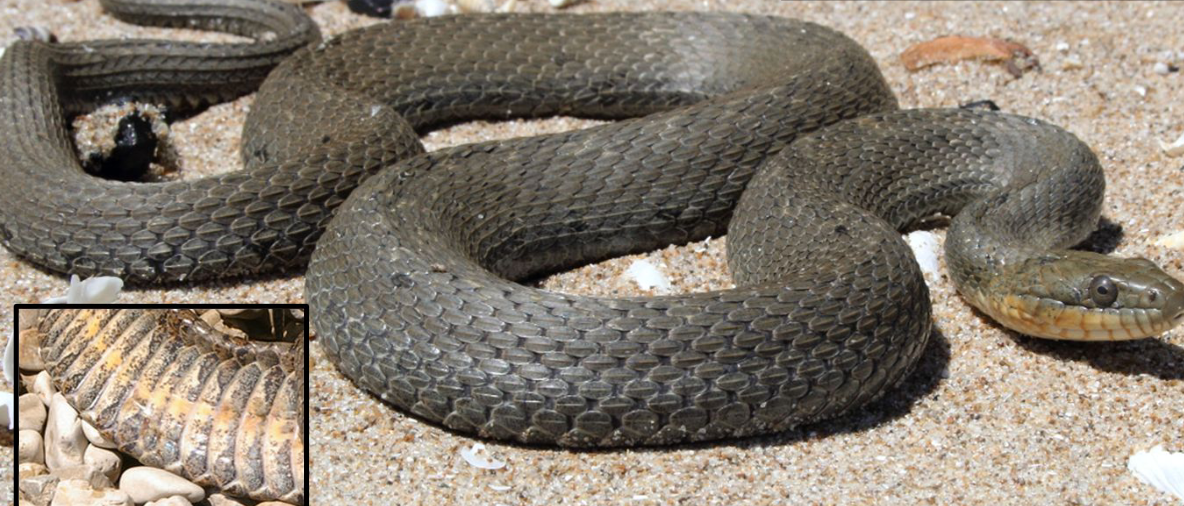
What is this
Nerodia spiedon insularum
Lake Erie Watersnake
Special concern
Family Colubridae
Found in Lake Erie
Background colour is grey, grey-brown or olive
Dark grey to light tan blotches may or may not be present on the length of body (this depends on individuals)
If there are blotches they are on the anterior portion of the body and is a saddle-shaped marking
Belly is cream to light yellow with varying amounts of flecking
if threatened they may flatten its body to appear larger, release an odorous fluid from its cloaca, and if handled it will actively defend itself
Feeds on round body in the great lakes
Scales are keeled
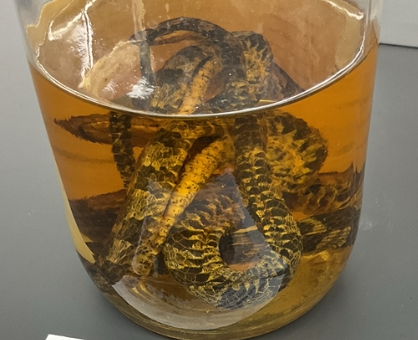
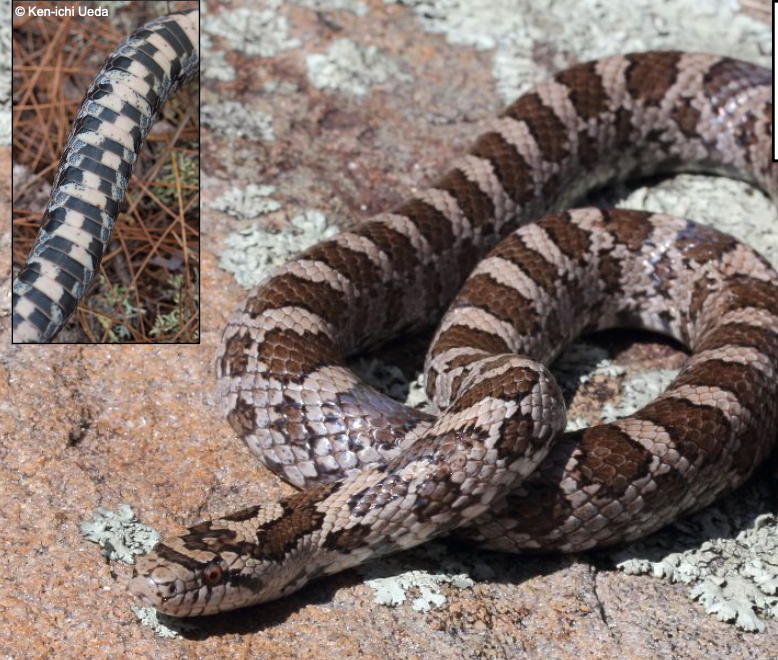
What is this
Lampropeltis traingulum
Eastern milksnake
Not at risk
Family Colubridae
Y-shape on head
grey to light brown background colour
Large, dark-bordered red or brown blotches along the back that alternating with smaller blotches along the sides
Spots may be saddle-shaped
White to cream belly has a black checkerboard pattern (juveniles may lack this)
Excellent climber
Found in basements of old homes to escape cold temperatures
They do not drink cow's milk as old folks tales suggest but is found around barns
if threatened this species will vibrate the tip of its tail, release a foul smelling liquid from its cloaca, assume a defensive strike position, and actively defend itself
Scales are smooth


What is this
Heterodon platirhinos
Eastern Hog-nosed Snake
Threatened
Family Colubridae
Colour and pattern are variable in this species
Large dark blotches along the back altering with smaller blotches along the sides
Background colour can be grey, green, yellow, orange, or black
Some adults have a solid dorsal colour of brown, olive, grey, or black
Belly can be cream or yellow with diffused with grey moltting
The snout is upright and looks like a triangle head
Heavy bodied snake with a short tail
Eats primarily toads
Master of fakery
If threatened will fire neck similar to of a cobra, vibrate its tip of its tail, release a foul-smelling liquid from its cloaca, assume a defensive strike position, gape its mouth, hiss loudly, strike with a closed mouth, and fake death in dramatic writhing form
Scales are weakly keeled
DIFFERENT HEAD
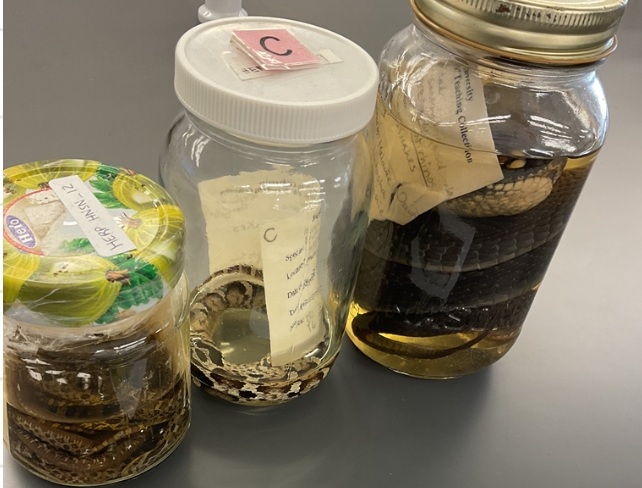
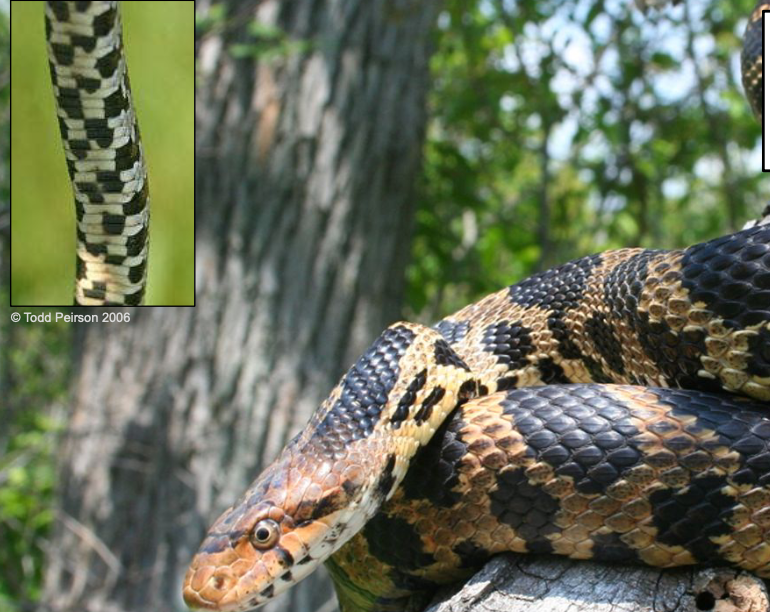
What is this
Pantherophis vulpinus
Eastern Fox Snake
Endangered/Threatened
Family Colubridae
Yellow to brown background colour
Large dark blotches along the back with smaller blotches on the side of body
Belly is cream to yellow with black checkerboard pattern
Head of an adult is copper brown
Young snakes have a grey to tan background colour with dark bordered, red-brown blotches.
Found in Great Lakes Basin
If threatened it will vibrate the tip of its tail, release a foul-smelling lipid from its cloaca, assume a defensive strike position and actively defend itself.
Kills prey by suffocation
Scales are weekly keeled
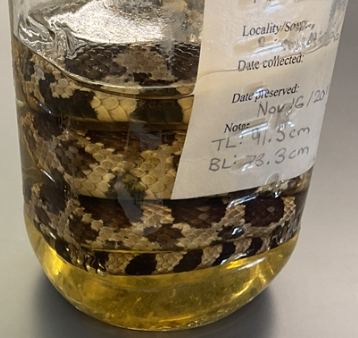

What is this
Pantherophis spiloides
Gray Ratsnake
Endangered/Threatened
Family Colubridae
Very long
Dorsal colour is glossy black
When it gets older remnants of lighter blotches of grey, white, or diffuse orange markings can be observed between scales
The throat, chin and lip scales are white
The belly is cream, white, yellow, or grey with a checkerboard pattern
Ontario's largest snake
If threatened it will vibrate its tail, release a foul-smelling fluid from its cloaca, and actively defend itself
It kills its prey by suffocating it
Scales are weakly keeled
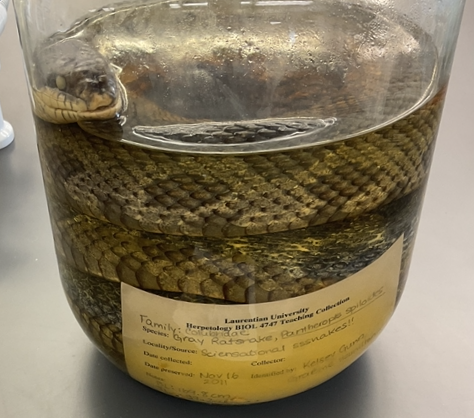
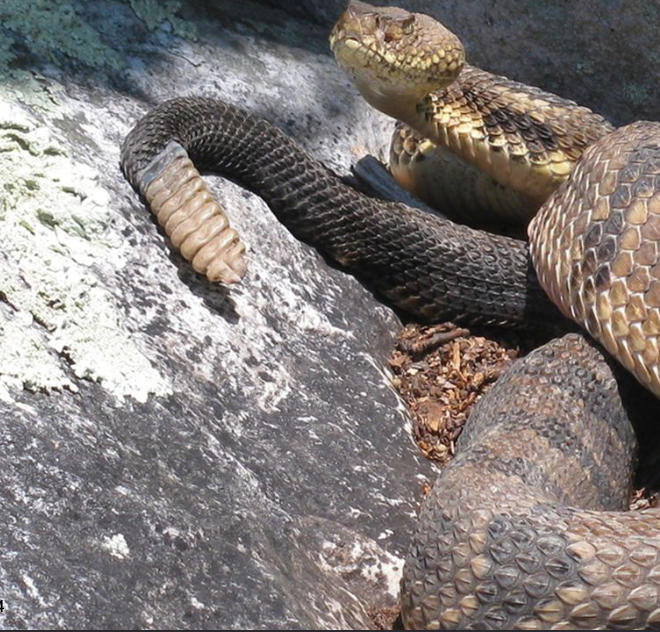
What is this
Crotalus horridus
Timber Rattlesnake
Extripated
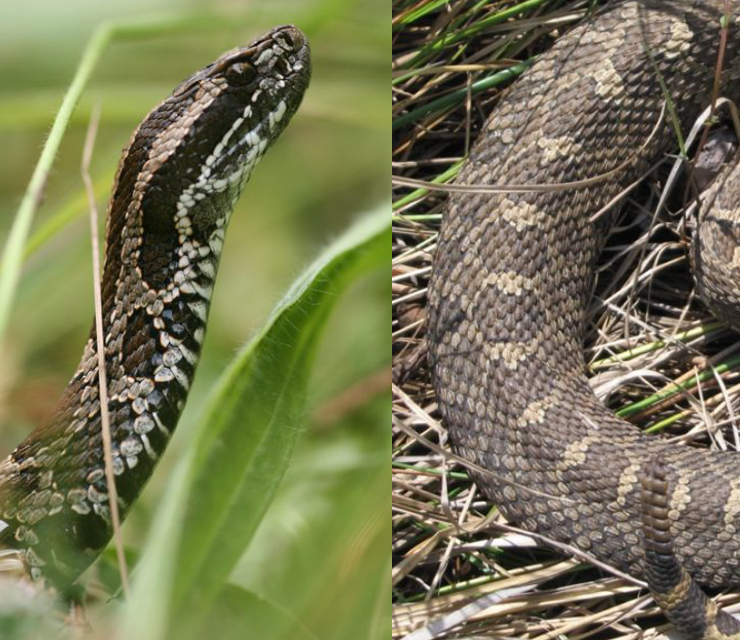
What is this
Sistrurus catenatus
Massasauge Rattlesnake
Endangered/Threatened


What is this
Plestiodon fasciatus
Five-lined skink
Blue tail
5 black lines down body
Yellow under lines
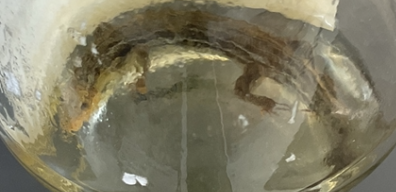

What is this
Chelydra serpentina
Snapping turtle
Special concern
Family Chelydridae
Broad and slightly domes carapace
Shell colour ranges from light brown to black with algae
The reduced plastron is cream to yellow in adults and black to cream in juveniles
Skin is grey, brown or black
Large head may be patterned with brown and black
Long tail with triangular dorsal projections
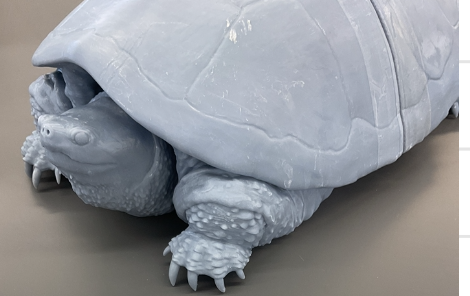
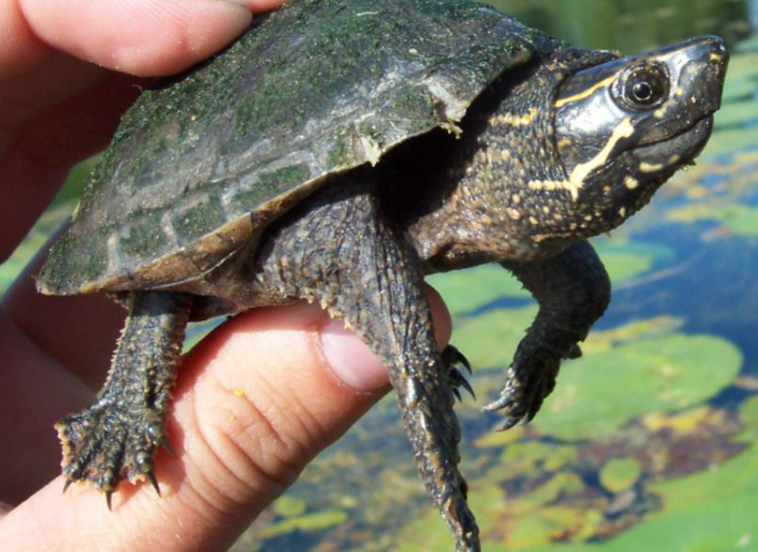
What is this
Sternotherus odoratus
Stinkpot/Eastern musk turtle
Special concern
Family Kinosternidae
Carapace is keeled and highly domed
Carapace is tan, cream, olive, or black with black flecks
Plastron is small, creamy to black in colour
Hinge present on plastron
Skin colour may be pink, grey, light brown or black with light striping and dark flecks
Under chin there are small fleshy projections (tubercles)
Their hatchlings are the smallest worlds species
They walk on the bottom of lakes and stuff
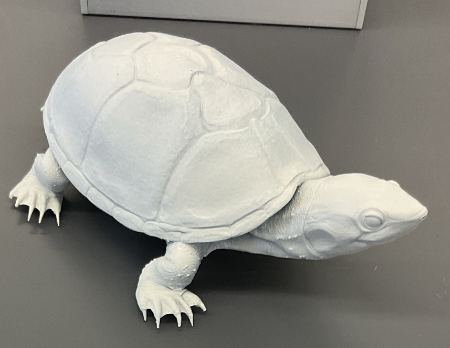
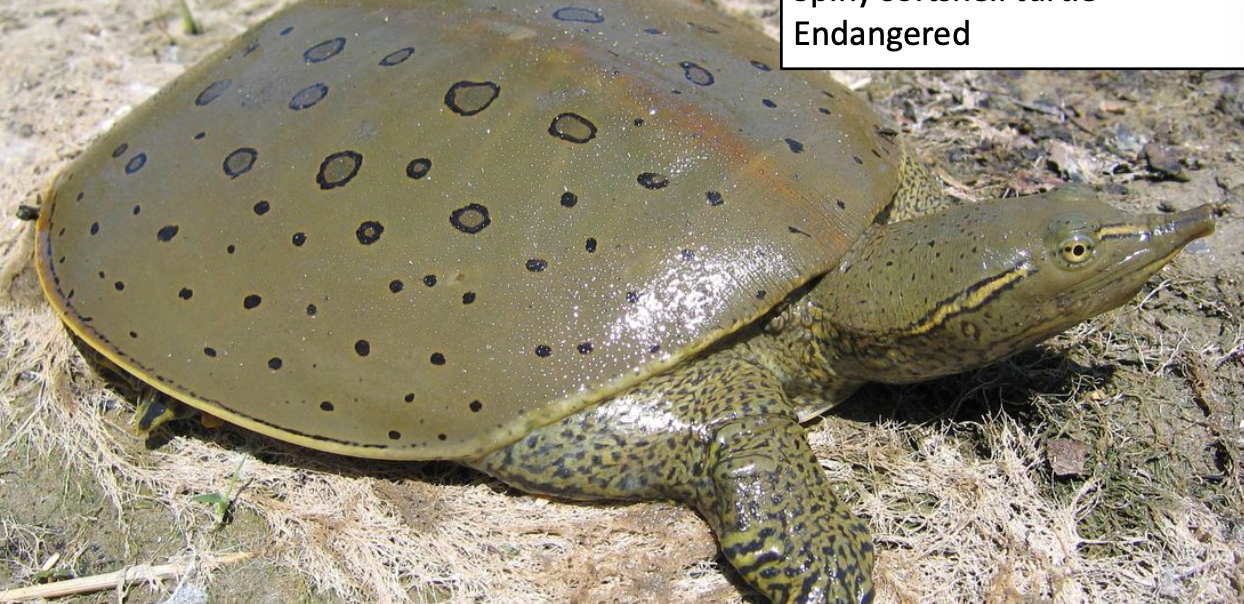
What is this
Apalone spineifera
Spiny softshell turtle
Endangered
Family Trionychidae
Flat shell
Shell is green with yellow border
Shell also has darker green spots with black outline
Plastron is white or cream with small blood vessels visable
On top, the legs and tails are green with yellow and black stripes, blotches and flecks
On bottom, legs are white or grey
They have long necks with dark border, yellow lines along each side of head
Snout is long and tubular
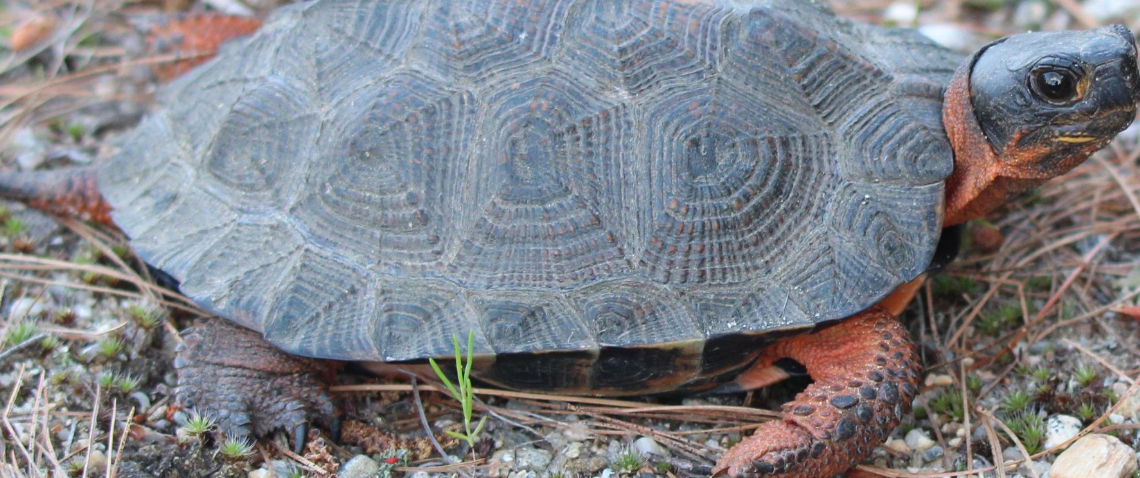
What is this
Glyptemys insculpta
Wood turtle
Endangered
Family Emydidae
Upper shell is keeled
On each Shute of shell the raised concentric growth rings are from age and time
The carapace colour is mustard yellow to cream with a black block on each shute
Legs and tails are grey to brown with large amount of orange on the forelegs and neck
Head is black and orange with gold flecking


What is this
Clemmys guattata
Spotted turtle
Endangered
Family Emididae
Straight line shell
Domed carapace
Carapace is black with small white, yellow, or orange spots
Plastron is orange to cream in colour with a black blotch on each scute
Legs and tail are grey to black with varying amounts o yellow, orange, and white spots
Males have a tan to black chin while females have a yellow to orange chin and eyes
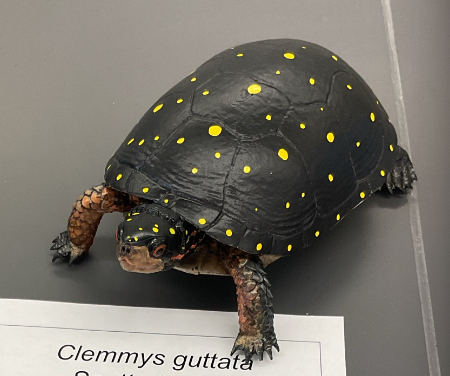
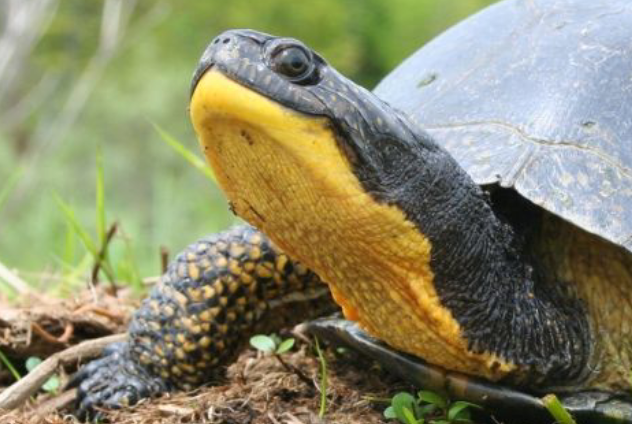
What is this
Emydoidea blandingii
Blanding's turtle
Threatened
Family Emididae
Highly domes carapace
Carapace is brown to black with white to yellow spots line or flecks
The hinged plastron is cream to yellow with a black blotch on each scute
The skin of the legs and tail ranges from grey to black with large amounts of yellow on the forelegs
Yellow chin and neck
Skin has yellow dots on the black skin
Males have a concave plastron and a longer, more robust tail than the adult females

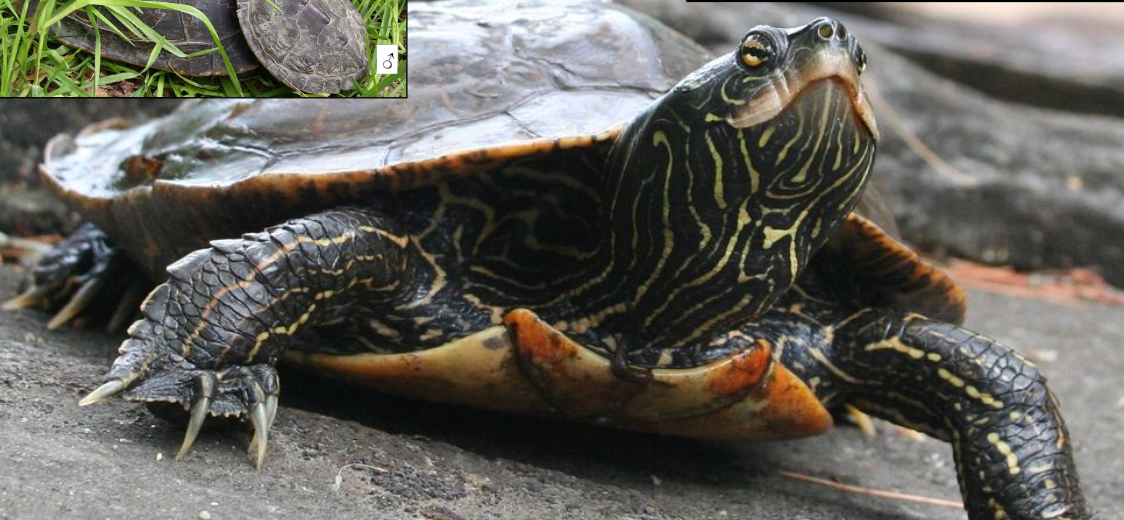
What is this
Graphemes geographica
Map turtle
Special concern
Family Emididae
Carapace is green to brown with yellow contoured line (like a map)
A keel is present on the midline of carapace
Plastron is a pink/cream to yellow colour
Skin is green with yellow lines
Beneath the eye there is a yellow spot
Adult females are much biggeEmydoidea blandinr than males
Females have a large, wide head
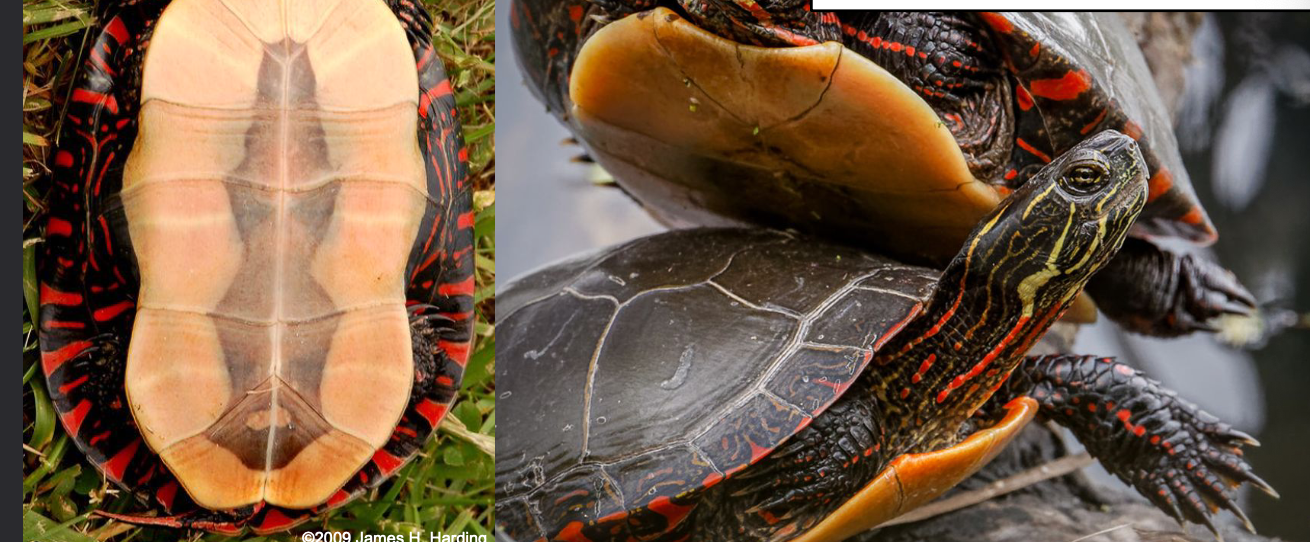
What is this
Chrysemys picta marginata
Midland painted turtle
Not at risk
Family Emididae
Smooth and oval carapace
Colour of carapace is love to brown with red barring and blotches on the margin and bridge of the shell
Plastron is cream to yellow with an elongated grey to black botch in the center
Skin is green with red and yellow stripes
Adult males have a less-domed carapace, longer tails and longer front claws
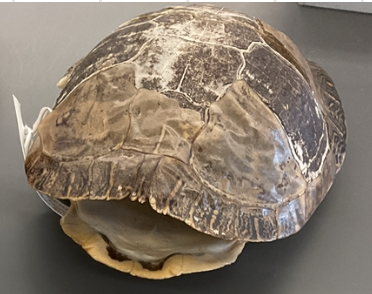
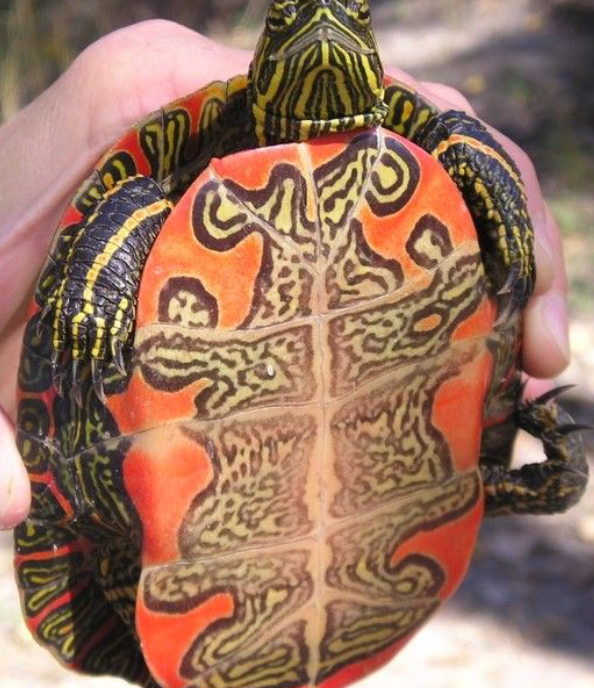
What is this
Chrysemys picta bellii
Western painted turtle
Not at risk
Family Emididae
Smooth oval carapace
Range of colour from olive to brown to varying amounts of red barring and blotches
Web-like pattern on each scute
Plasteron is generally cream, yellow, pink, or red with a large black/grey blotch in the centre
Skin is green and with yellow stripes on neck and head
Adult males have a less-domed carapace, longer tails, and longer fore claws
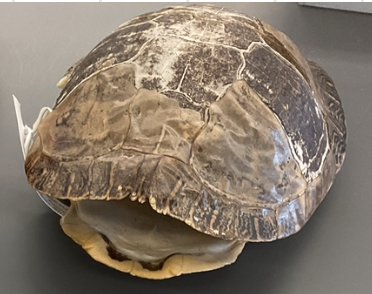
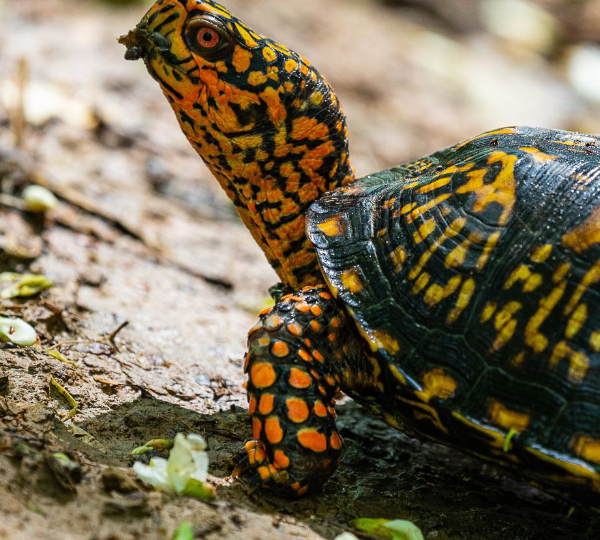
What is this
Terrepene carolina
Eastern box turtle
Extripated
Family Emididae
Carapace is highly domed and keeled but smooth with age
Pattern on shell is dark brown to black on the background, but the pattern varies of yellow and orange
Its plastron is hinged and is tan to black
Tail and legs are black to brown with yellow, red, or orange markings
On an adult the head is black to brown with patterns with yellow, orange or red spots
Males have a slight concavity on plastron and longer tails

What is the call group and description of Wood Frog calls
Croak
Croak in like beeps
Rhythmic
Choppy
Sounds like a duck quacking
What is the call group and description of Spring Pepper calls
Peep
High peeping
What is the call group and description of Chorus Frog calls
Trill
Finger on Comb
What is the call group and description of American Toad calls
Trill
Long Trip
Constant
What is the call group and description of Fowler’s Toad calls
Trill
Yelling at you
What is the call group and description of Leopard Frog calls
Croak
Long call
Multiple notes in call in form of croaking
Sounds like a woodpecker
What is the call group and description of Pickerel Frog calls
Croak
Burp
Creaking door
What is the call group and description of Gray Tree Frog calls
Trill
Angry red squirrel
Like a bird
What is the call group and description of Bullforg calls
Twang
Arirplane driving by
‘ja-ga-rum’
What is the call group and description of Mink Frog calls
Twang
Old car starting
What is the call group and description of Green Frog calls
Croak or Twang
Loose banjo strings
Stop and go croak
How do you observe Fundamental frequency (FF) (kHz)
It is the lowest frequency of the call
How do you observe the Dominant Frequency (DF) (kHz)
Where the majority of the sound is at
Like where it stays consistent
How do you observe Frequency Modulation (FM)
?
How do you observe Harmonics (kHz)
?
How do you observe Band Width (kHz)
?
How do you observe Amplitude Modulating
?
How do you observe Call Length (s)
?
How do you observe Note Length (s)
?
How do you observe Pulse Rate (pps)
PR = # pulses / # seconds = ? pulses / 1 second
How do you observe Rise time (s)
?
How do you observe Decay time (s)
?